Parents’ perception and understanding of Neurofen use in children with Chicken Pox and associated risks
VerifiedAdded on 2023/01/23
|27
|6691
|65
AI Summary
This research proposal aims to elucidate the perception and understanding of parents regarding the use of Neurofen in children with Chicken Pox and the associated risks. The proposal outlines the research methodology, including the research design, sampling strategy, data collection methods, and data analysis. The study aims to conduct qualitative research through semi-structured interviews with 20 prospective parents selected from public run hospitals. The research will provide valuable insights into the effective management of fever and complications associated with Chicken Pox and the use of NSAIDs.
Contribute Materials
Your contribution can guide someone’s learning journey. Share your
documents today.
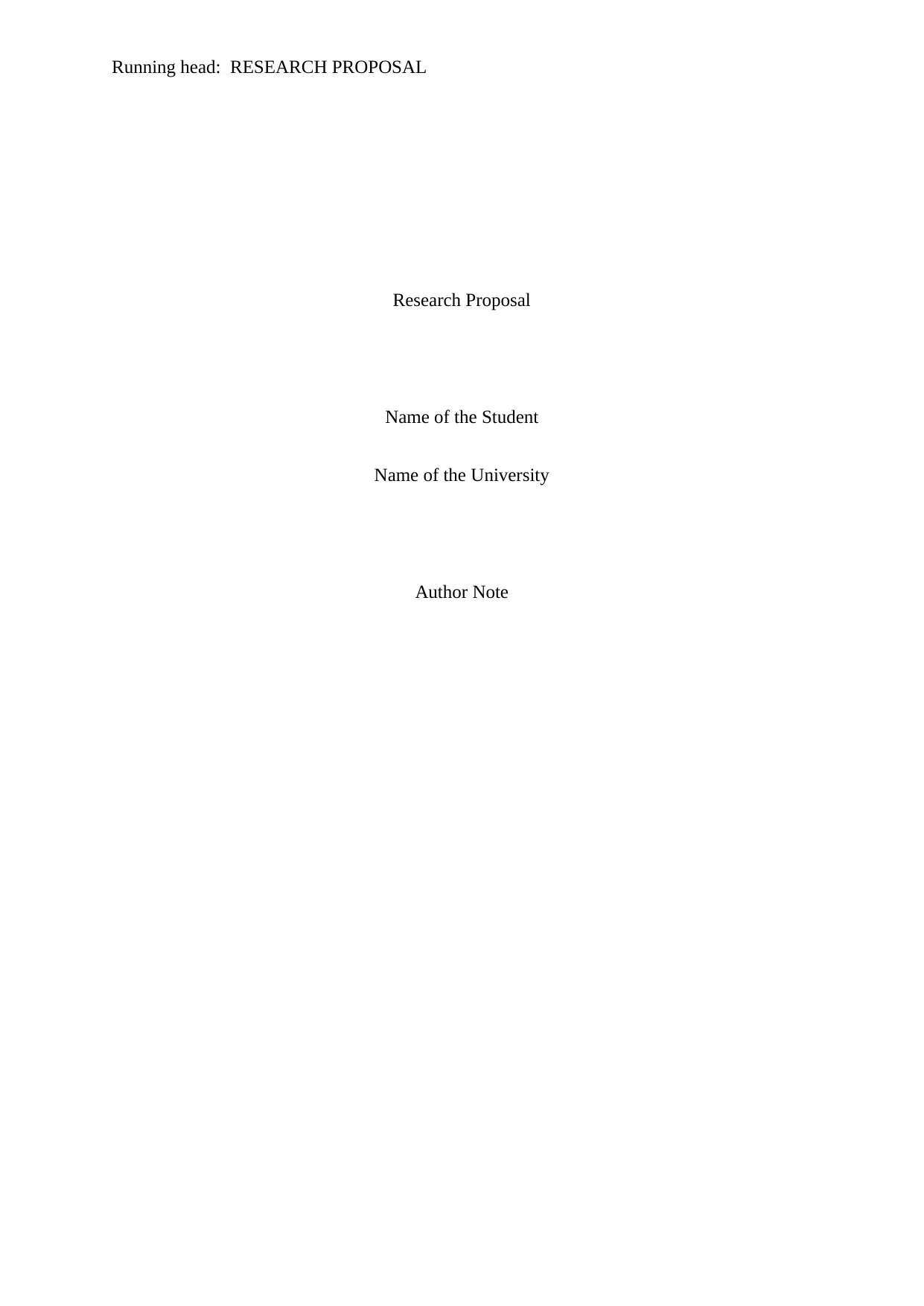
Running head: RESEARCH PROPOSAL
Research Proposal
Name of the Student
Name of the University
Author Note
Research Proposal
Name of the Student
Name of the University
Author Note
Secure Best Marks with AI Grader
Need help grading? Try our AI Grader for instant feedback on your assignments.
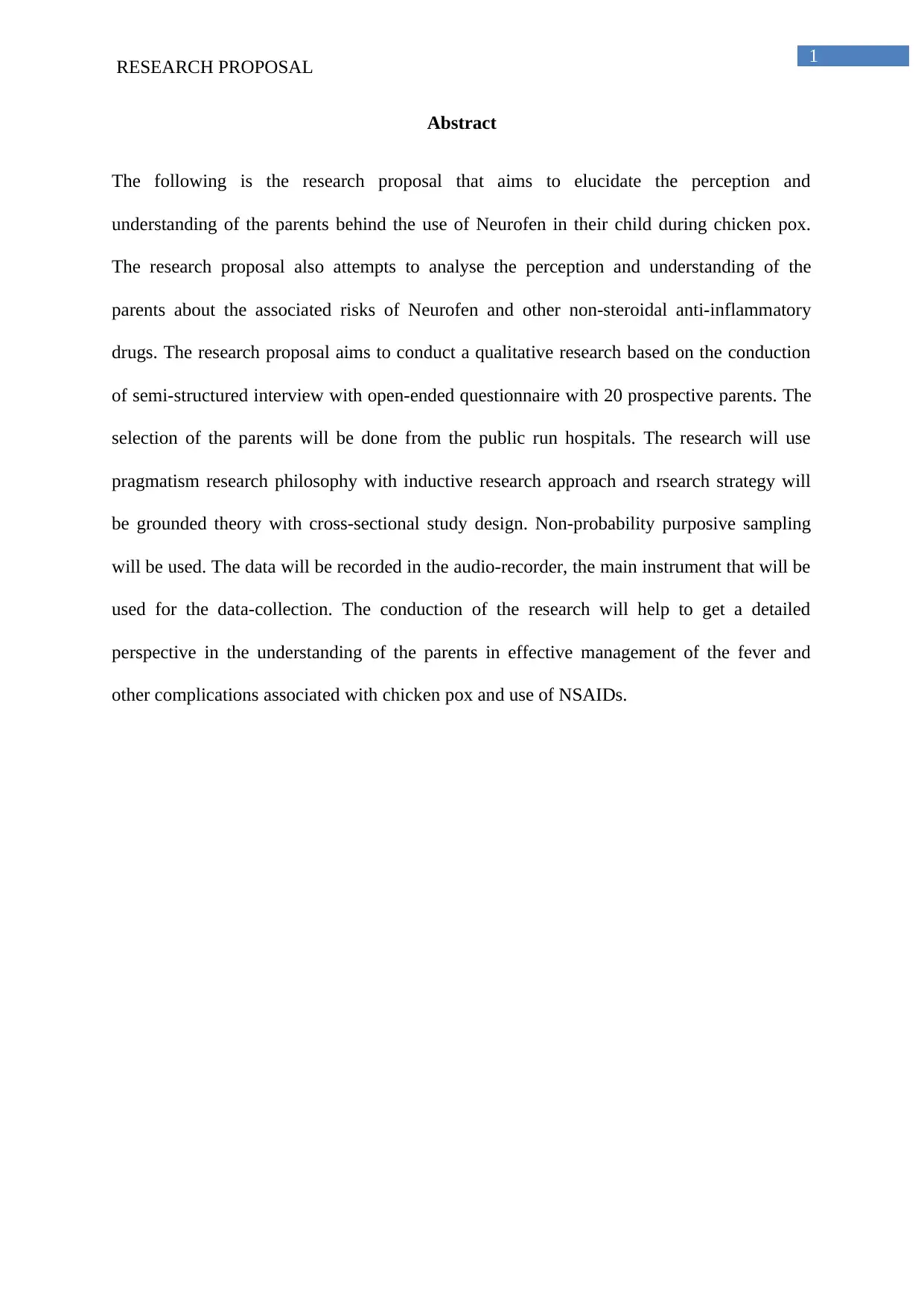
1
RESEARCH PROPOSAL
Abstract
The following is the research proposal that aims to elucidate the perception and
understanding of the parents behind the use of Neurofen in their child during chicken pox.
The research proposal also attempts to analyse the perception and understanding of the
parents about the associated risks of Neurofen and other non-steroidal anti-inflammatory
drugs. The research proposal aims to conduct a qualitative research based on the conduction
of semi-structured interview with open-ended questionnaire with 20 prospective parents. The
selection of the parents will be done from the public run hospitals. The research will use
pragmatism research philosophy with inductive research approach and rsearch strategy will
be grounded theory with cross-sectional study design. Non-probability purposive sampling
will be used. The data will be recorded in the audio-recorder, the main instrument that will be
used for the data-collection. The conduction of the research will help to get a detailed
perspective in the understanding of the parents in effective management of the fever and
other complications associated with chicken pox and use of NSAIDs.
RESEARCH PROPOSAL
Abstract
The following is the research proposal that aims to elucidate the perception and
understanding of the parents behind the use of Neurofen in their child during chicken pox.
The research proposal also attempts to analyse the perception and understanding of the
parents about the associated risks of Neurofen and other non-steroidal anti-inflammatory
drugs. The research proposal aims to conduct a qualitative research based on the conduction
of semi-structured interview with open-ended questionnaire with 20 prospective parents. The
selection of the parents will be done from the public run hospitals. The research will use
pragmatism research philosophy with inductive research approach and rsearch strategy will
be grounded theory with cross-sectional study design. Non-probability purposive sampling
will be used. The data will be recorded in the audio-recorder, the main instrument that will be
used for the data-collection. The conduction of the research will help to get a detailed
perspective in the understanding of the parents in effective management of the fever and
other complications associated with chicken pox and use of NSAIDs.
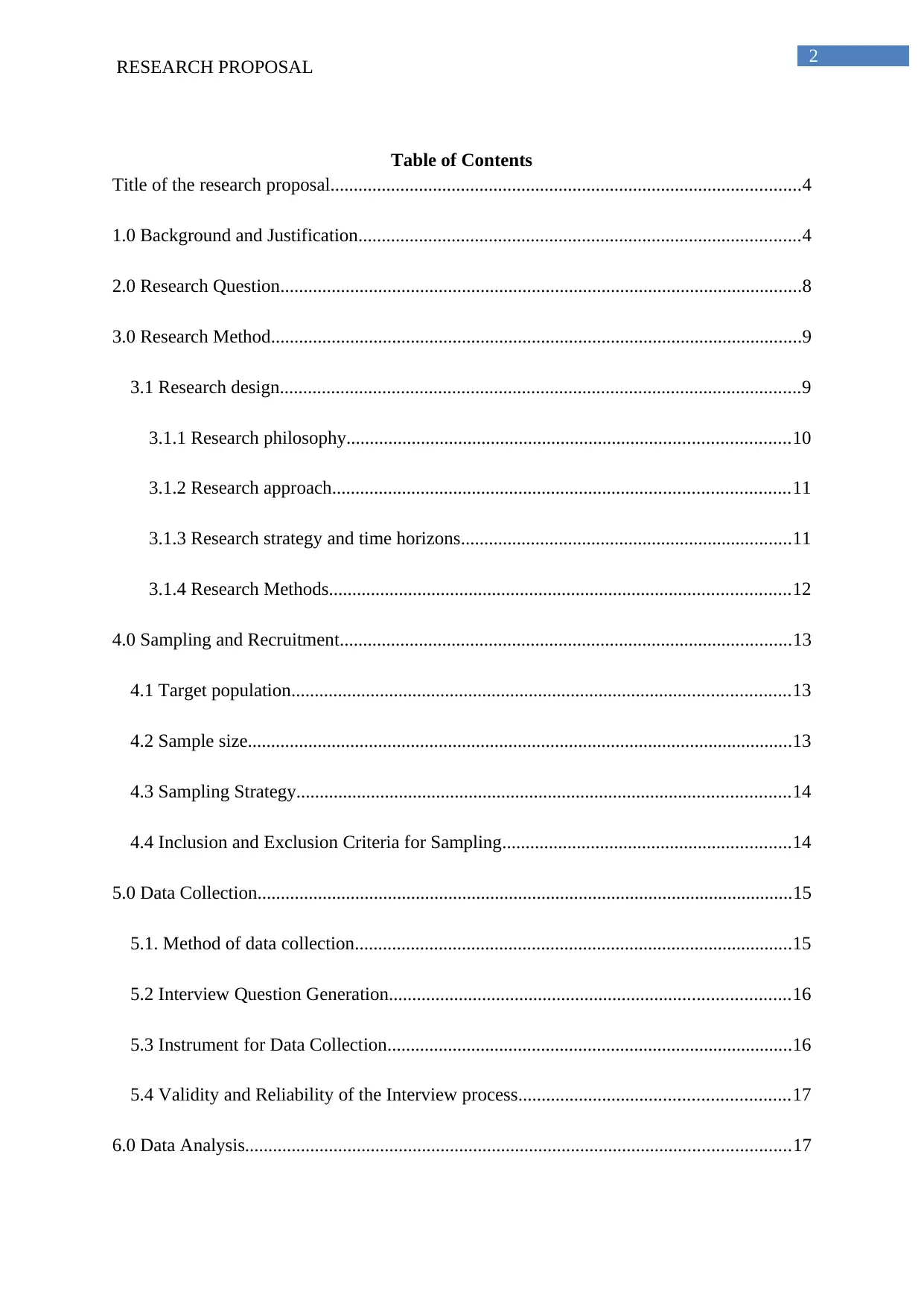
2
RESEARCH PROPOSAL
Table of Contents
Title of the research proposal.....................................................................................................4
1.0 Background and Justification...............................................................................................4
2.0 Research Question................................................................................................................8
3.0 Research Method..................................................................................................................9
3.1 Research design................................................................................................................9
3.1.1 Research philosophy...............................................................................................10
3.1.2 Research approach..................................................................................................11
3.1.3 Research strategy and time horizons.......................................................................11
3.1.4 Research Methods...................................................................................................12
4.0 Sampling and Recruitment.................................................................................................13
4.1 Target population...........................................................................................................13
4.2 Sample size.....................................................................................................................13
4.3 Sampling Strategy..........................................................................................................14
4.4 Inclusion and Exclusion Criteria for Sampling..............................................................14
5.0 Data Collection...................................................................................................................15
5.1. Method of data collection..............................................................................................15
5.2 Interview Question Generation......................................................................................16
5.3 Instrument for Data Collection.......................................................................................16
5.4 Validity and Reliability of the Interview process..........................................................17
6.0 Data Analysis.....................................................................................................................17
RESEARCH PROPOSAL
Table of Contents
Title of the research proposal.....................................................................................................4
1.0 Background and Justification...............................................................................................4
2.0 Research Question................................................................................................................8
3.0 Research Method..................................................................................................................9
3.1 Research design................................................................................................................9
3.1.1 Research philosophy...............................................................................................10
3.1.2 Research approach..................................................................................................11
3.1.3 Research strategy and time horizons.......................................................................11
3.1.4 Research Methods...................................................................................................12
4.0 Sampling and Recruitment.................................................................................................13
4.1 Target population...........................................................................................................13
4.2 Sample size.....................................................................................................................13
4.3 Sampling Strategy..........................................................................................................14
4.4 Inclusion and Exclusion Criteria for Sampling..............................................................14
5.0 Data Collection...................................................................................................................15
5.1. Method of data collection..............................................................................................15
5.2 Interview Question Generation......................................................................................16
5.3 Instrument for Data Collection.......................................................................................16
5.4 Validity and Reliability of the Interview process..........................................................17
6.0 Data Analysis.....................................................................................................................17

3
RESEARCH PROPOSAL
7.0 Ethical Consideration of the Research...............................................................................19
References................................................................................................................................21
Appendix..................................................................................................................................25
RESEARCH PROPOSAL
7.0 Ethical Consideration of the Research...............................................................................19
References................................................................................................................................21
Appendix..................................................................................................................................25
Secure Best Marks with AI Grader
Need help grading? Try our AI Grader for instant feedback on your assignments.
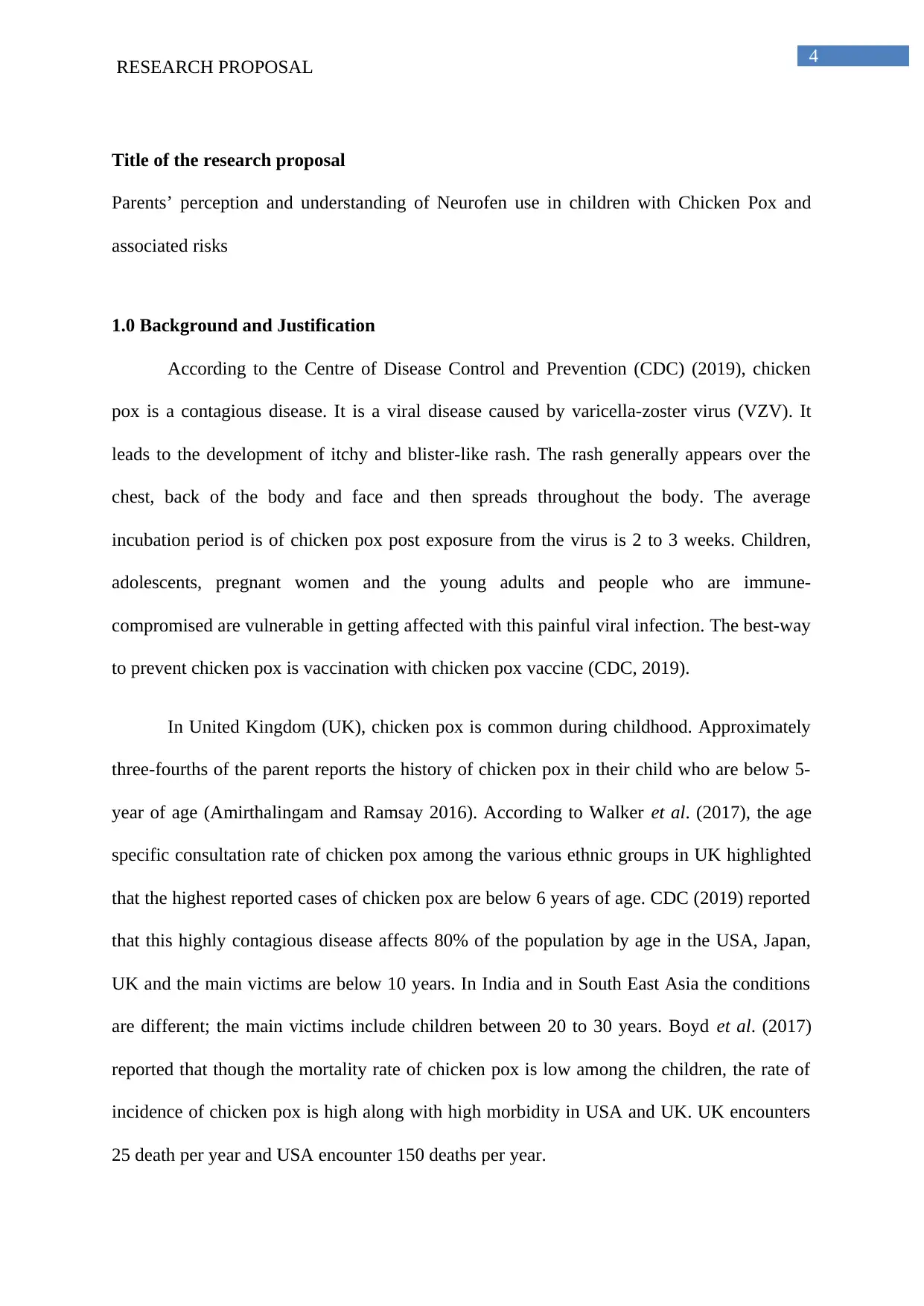
4
RESEARCH PROPOSAL
Title of the research proposal
Parents’ perception and understanding of Neurofen use in children with Chicken Pox and
associated risks
1.0 Background and Justification
According to the Centre of Disease Control and Prevention (CDC) (2019), chicken
pox is a contagious disease. It is a viral disease caused by varicella-zoster virus (VZV). It
leads to the development of itchy and blister-like rash. The rash generally appears over the
chest, back of the body and face and then spreads throughout the body. The average
incubation period is of chicken pox post exposure from the virus is 2 to 3 weeks. Children,
adolescents, pregnant women and the young adults and people who are immune-
compromised are vulnerable in getting affected with this painful viral infection. The best-way
to prevent chicken pox is vaccination with chicken pox vaccine (CDC, 2019).
In United Kingdom (UK), chicken pox is common during childhood. Approximately
three-fourths of the parent reports the history of chicken pox in their child who are below 5-
year of age (Amirthalingam and Ramsay 2016). According to Walker et al. (2017), the age
specific consultation rate of chicken pox among the various ethnic groups in UK highlighted
that the highest reported cases of chicken pox are below 6 years of age. CDC (2019) reported
that this highly contagious disease affects 80% of the population by age in the USA, Japan,
UK and the main victims are below 10 years. In India and in South East Asia the conditions
are different; the main victims include children between 20 to 30 years. Boyd et al. (2017)
reported that though the mortality rate of chicken pox is low among the children, the rate of
incidence of chicken pox is high along with high morbidity in USA and UK. UK encounters
25 death per year and USA encounter 150 deaths per year.
RESEARCH PROPOSAL
Title of the research proposal
Parents’ perception and understanding of Neurofen use in children with Chicken Pox and
associated risks
1.0 Background and Justification
According to the Centre of Disease Control and Prevention (CDC) (2019), chicken
pox is a contagious disease. It is a viral disease caused by varicella-zoster virus (VZV). It
leads to the development of itchy and blister-like rash. The rash generally appears over the
chest, back of the body and face and then spreads throughout the body. The average
incubation period is of chicken pox post exposure from the virus is 2 to 3 weeks. Children,
adolescents, pregnant women and the young adults and people who are immune-
compromised are vulnerable in getting affected with this painful viral infection. The best-way
to prevent chicken pox is vaccination with chicken pox vaccine (CDC, 2019).
In United Kingdom (UK), chicken pox is common during childhood. Approximately
three-fourths of the parent reports the history of chicken pox in their child who are below 5-
year of age (Amirthalingam and Ramsay 2016). According to Walker et al. (2017), the age
specific consultation rate of chicken pox among the various ethnic groups in UK highlighted
that the highest reported cases of chicken pox are below 6 years of age. CDC (2019) reported
that this highly contagious disease affects 80% of the population by age in the USA, Japan,
UK and the main victims are below 10 years. In India and in South East Asia the conditions
are different; the main victims include children between 20 to 30 years. Boyd et al. (2017)
reported that though the mortality rate of chicken pox is low among the children, the rate of
incidence of chicken pox is high along with high morbidity in USA and UK. UK encounters
25 death per year and USA encounter 150 deaths per year.
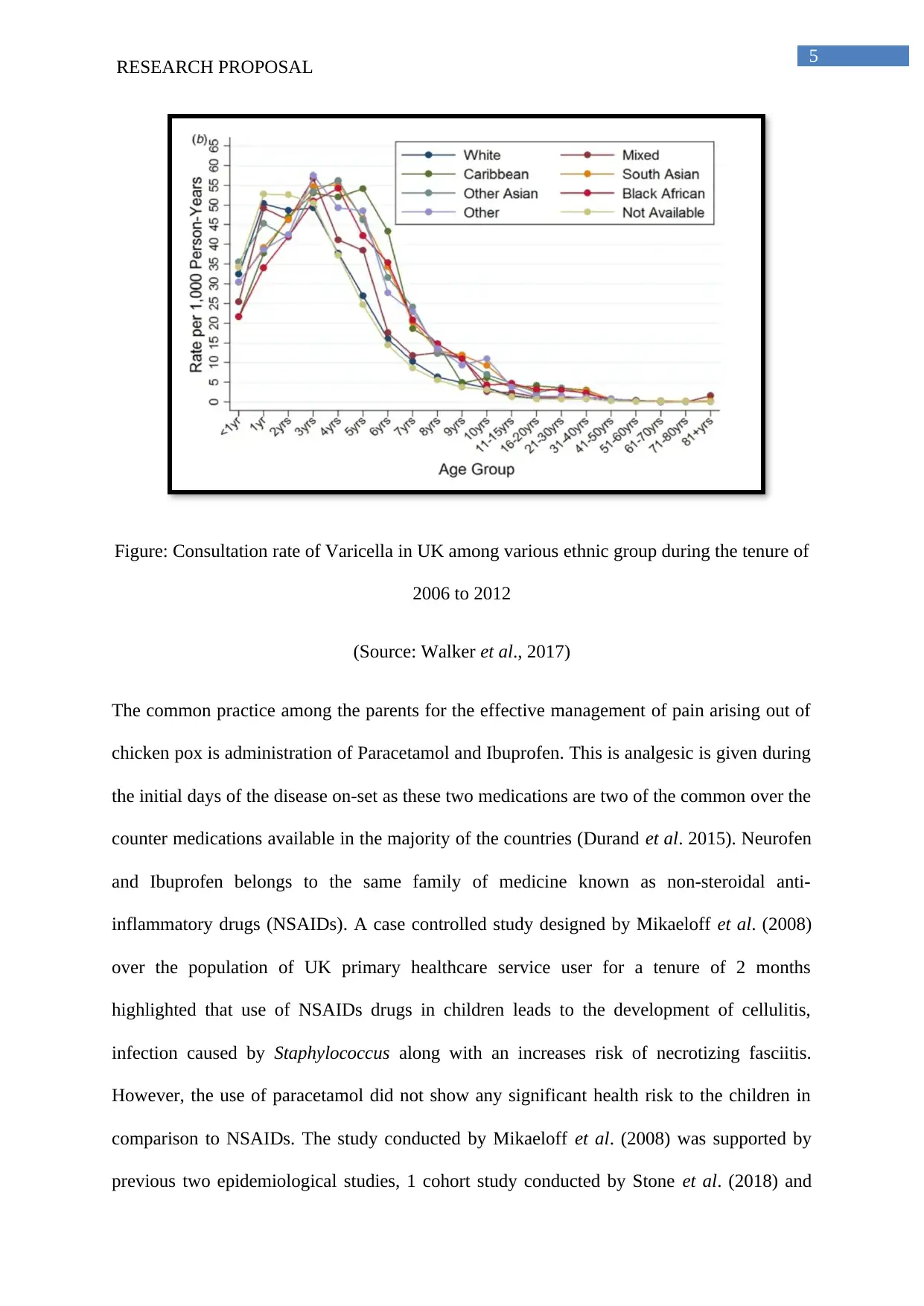
5
RESEARCH PROPOSAL
Figure: Consultation rate of Varicella in UK among various ethnic group during the tenure of
2006 to 2012
(Source: Walker et al., 2017)
The common practice among the parents for the effective management of pain arising out of
chicken pox is administration of Paracetamol and Ibuprofen. This is analgesic is given during
the initial days of the disease on-set as these two medications are two of the common over the
counter medications available in the majority of the countries (Durand et al. 2015). Neurofen
and Ibuprofen belongs to the same family of medicine known as non-steroidal anti-
inflammatory drugs (NSAIDs). A case controlled study designed by Mikaeloff et al. (2008)
over the population of UK primary healthcare service user for a tenure of 2 months
highlighted that use of NSAIDs drugs in children leads to the development of cellulitis,
infection caused by Staphylococcus along with an increases risk of necrotizing fasciitis.
However, the use of paracetamol did not show any significant health risk to the children in
comparison to NSAIDs. The study conducted by Mikaeloff et al. (2008) was supported by
previous two epidemiological studies, 1 cohort study conducted by Stone et al. (2018) and
RESEARCH PROPOSAL
Figure: Consultation rate of Varicella in UK among various ethnic group during the tenure of
2006 to 2012
(Source: Walker et al., 2017)
The common practice among the parents for the effective management of pain arising out of
chicken pox is administration of Paracetamol and Ibuprofen. This is analgesic is given during
the initial days of the disease on-set as these two medications are two of the common over the
counter medications available in the majority of the countries (Durand et al. 2015). Neurofen
and Ibuprofen belongs to the same family of medicine known as non-steroidal anti-
inflammatory drugs (NSAIDs). A case controlled study designed by Mikaeloff et al. (2008)
over the population of UK primary healthcare service user for a tenure of 2 months
highlighted that use of NSAIDs drugs in children leads to the development of cellulitis,
infection caused by Staphylococcus along with an increases risk of necrotizing fasciitis.
However, the use of paracetamol did not show any significant health risk to the children in
comparison to NSAIDs. The study conducted by Mikaeloff et al. (2008) was supported by
previous two epidemiological studies, 1 cohort study conducted by Stone et al. (2018) and
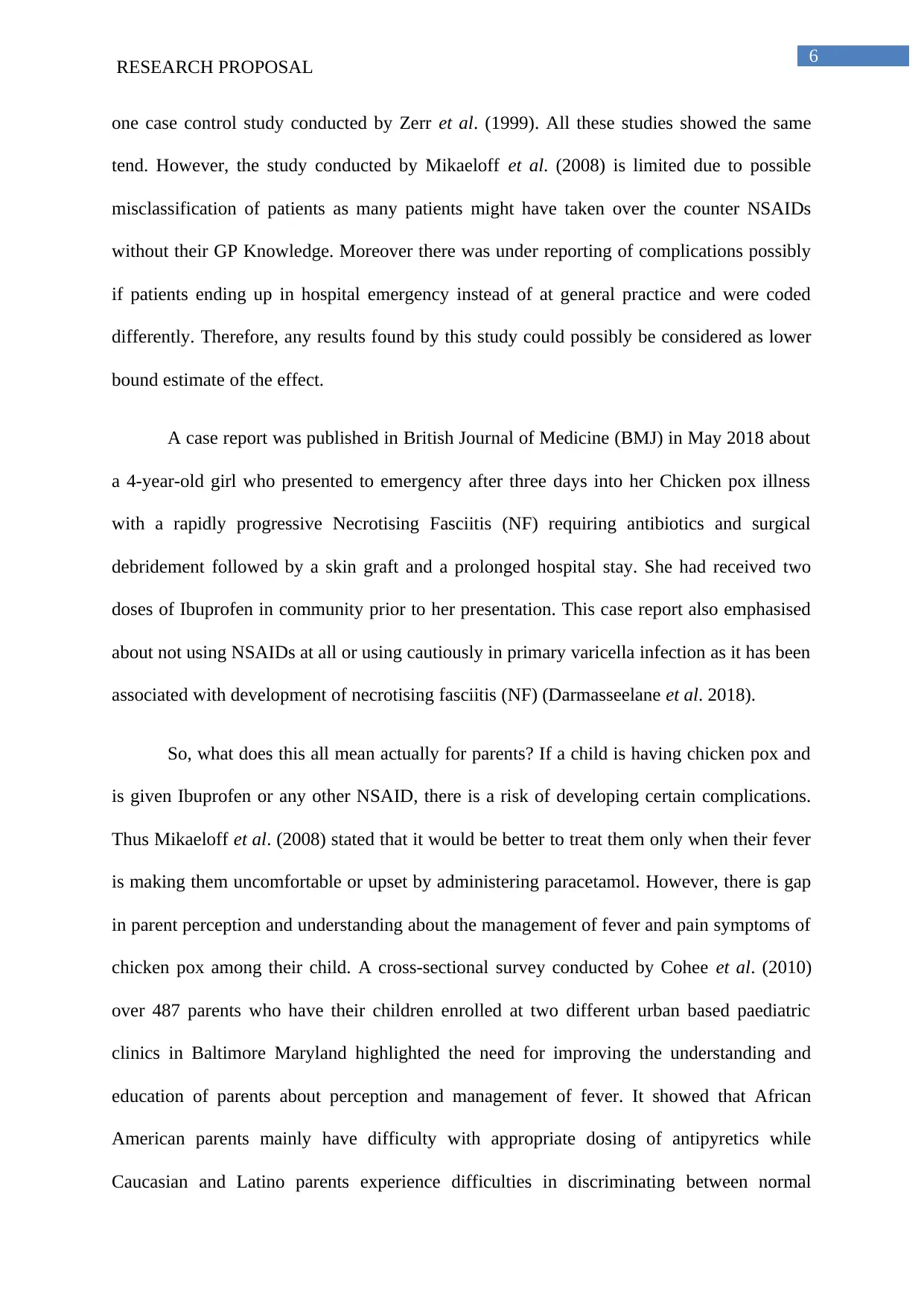
6
RESEARCH PROPOSAL
one case control study conducted by Zerr et al. (1999). All these studies showed the same
tend. However, the study conducted by Mikaeloff et al. (2008) is limited due to possible
misclassification of patients as many patients might have taken over the counter NSAIDs
without their GP Knowledge. Moreover there was under reporting of complications possibly
if patients ending up in hospital emergency instead of at general practice and were coded
differently. Therefore, any results found by this study could possibly be considered as lower
bound estimate of the effect.
A case report was published in British Journal of Medicine (BMJ) in May 2018 about
a 4-year-old girl who presented to emergency after three days into her Chicken pox illness
with a rapidly progressive Necrotising Fasciitis (NF) requiring antibiotics and surgical
debridement followed by a skin graft and a prolonged hospital stay. She had received two
doses of Ibuprofen in community prior to her presentation. This case report also emphasised
about not using NSAIDs at all or using cautiously in primary varicella infection as it has been
associated with development of necrotising fasciitis (NF) (Darmasseelane et al. 2018).
So, what does this all mean actually for parents? If a child is having chicken pox and
is given Ibuprofen or any other NSAID, there is a risk of developing certain complications.
Thus Mikaeloff et al. (2008) stated that it would be better to treat them only when their fever
is making them uncomfortable or upset by administering paracetamol. However, there is gap
in parent perception and understanding about the management of fever and pain symptoms of
chicken pox among their child. A cross-sectional survey conducted by Cohee et al. (2010)
over 487 parents who have their children enrolled at two different urban based paediatric
clinics in Baltimore Maryland highlighted the need for improving the understanding and
education of parents about perception and management of fever. It showed that African
American parents mainly have difficulty with appropriate dosing of antipyretics while
Caucasian and Latino parents experience difficulties in discriminating between normal
RESEARCH PROPOSAL
one case control study conducted by Zerr et al. (1999). All these studies showed the same
tend. However, the study conducted by Mikaeloff et al. (2008) is limited due to possible
misclassification of patients as many patients might have taken over the counter NSAIDs
without their GP Knowledge. Moreover there was under reporting of complications possibly
if patients ending up in hospital emergency instead of at general practice and were coded
differently. Therefore, any results found by this study could possibly be considered as lower
bound estimate of the effect.
A case report was published in British Journal of Medicine (BMJ) in May 2018 about
a 4-year-old girl who presented to emergency after three days into her Chicken pox illness
with a rapidly progressive Necrotising Fasciitis (NF) requiring antibiotics and surgical
debridement followed by a skin graft and a prolonged hospital stay. She had received two
doses of Ibuprofen in community prior to her presentation. This case report also emphasised
about not using NSAIDs at all or using cautiously in primary varicella infection as it has been
associated with development of necrotising fasciitis (NF) (Darmasseelane et al. 2018).
So, what does this all mean actually for parents? If a child is having chicken pox and
is given Ibuprofen or any other NSAID, there is a risk of developing certain complications.
Thus Mikaeloff et al. (2008) stated that it would be better to treat them only when their fever
is making them uncomfortable or upset by administering paracetamol. However, there is gap
in parent perception and understanding about the management of fever and pain symptoms of
chicken pox among their child. A cross-sectional survey conducted by Cohee et al. (2010)
over 487 parents who have their children enrolled at two different urban based paediatric
clinics in Baltimore Maryland highlighted the need for improving the understanding and
education of parents about perception and management of fever. It showed that African
American parents mainly have difficulty with appropriate dosing of antipyretics while
Caucasian and Latino parents experience difficulties in discriminating between normal
Paraphrase This Document
Need a fresh take? Get an instant paraphrase of this document with our AI Paraphraser
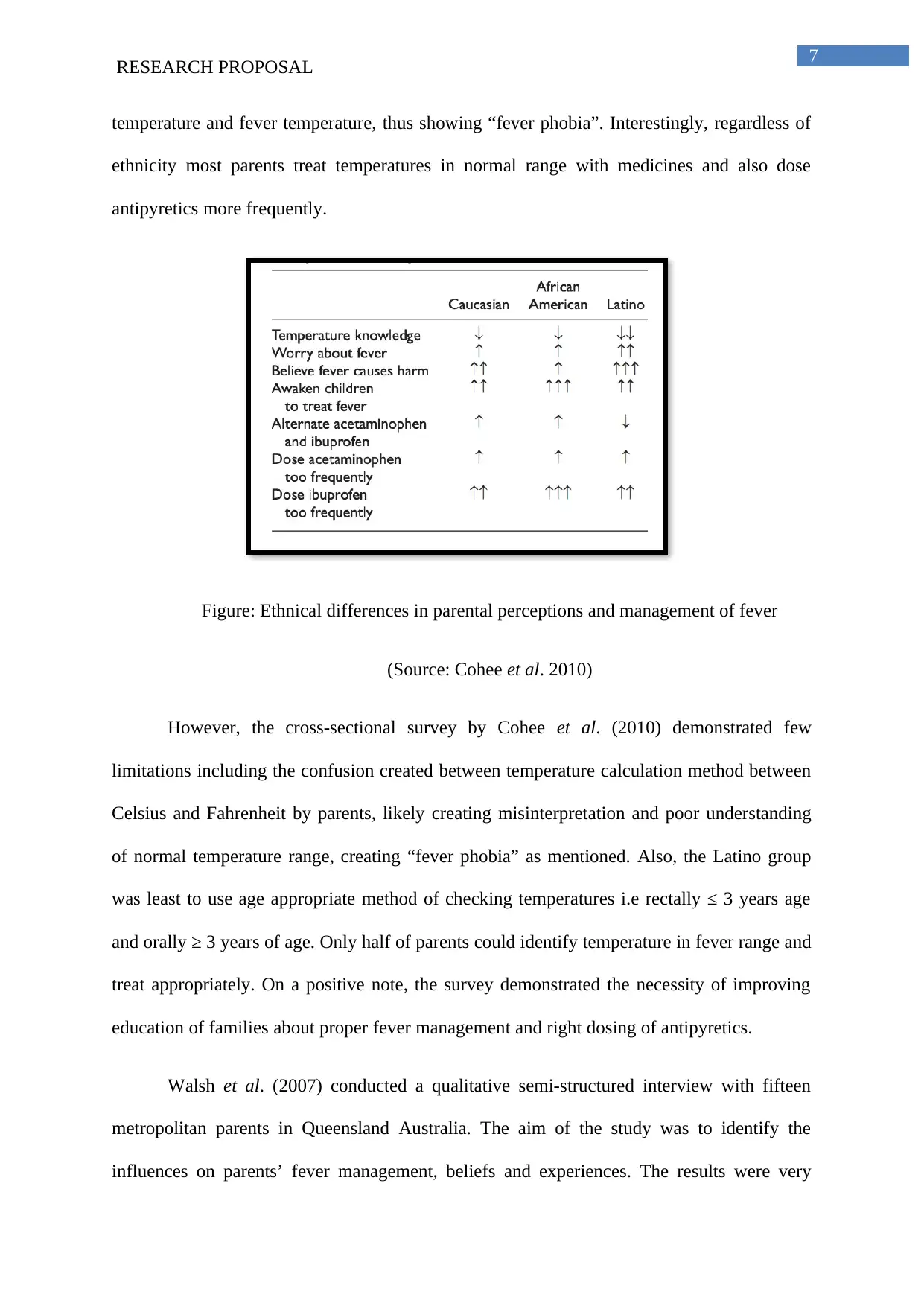
7
RESEARCH PROPOSAL
temperature and fever temperature, thus showing “fever phobia”. Interestingly, regardless of
ethnicity most parents treat temperatures in normal range with medicines and also dose
antipyretics more frequently.
Figure: Ethnical differences in parental perceptions and management of fever
(Source: Cohee et al. 2010)
However, the cross-sectional survey by Cohee et al. (2010) demonstrated few
limitations including the confusion created between temperature calculation method between
Celsius and Fahrenheit by parents, likely creating misinterpretation and poor understanding
of normal temperature range, creating “fever phobia” as mentioned. Also, the Latino group
was least to use age appropriate method of checking temperatures i.e rectally ≤ 3 years age
and orally ≥ 3 years of age. Only half of parents could identify temperature in fever range and
treat appropriately. On a positive note, the survey demonstrated the necessity of improving
education of families about proper fever management and right dosing of antipyretics.
Walsh et al. (2007) conducted a qualitative semi-structured interview with fifteen
metropolitan parents in Queensland Australia. The aim of the study was to identify the
influences on parents’ fever management, beliefs and experiences. The results were very
RESEARCH PROPOSAL
temperature and fever temperature, thus showing “fever phobia”. Interestingly, regardless of
ethnicity most parents treat temperatures in normal range with medicines and also dose
antipyretics more frequently.
Figure: Ethnical differences in parental perceptions and management of fever
(Source: Cohee et al. 2010)
However, the cross-sectional survey by Cohee et al. (2010) demonstrated few
limitations including the confusion created between temperature calculation method between
Celsius and Fahrenheit by parents, likely creating misinterpretation and poor understanding
of normal temperature range, creating “fever phobia” as mentioned. Also, the Latino group
was least to use age appropriate method of checking temperatures i.e rectally ≤ 3 years age
and orally ≥ 3 years of age. Only half of parents could identify temperature in fever range and
treat appropriately. On a positive note, the survey demonstrated the necessity of improving
education of families about proper fever management and right dosing of antipyretics.
Walsh et al. (2007) conducted a qualitative semi-structured interview with fifteen
metropolitan parents in Queensland Australia. The aim of the study was to identify the
influences on parents’ fever management, beliefs and experiences. The results were very
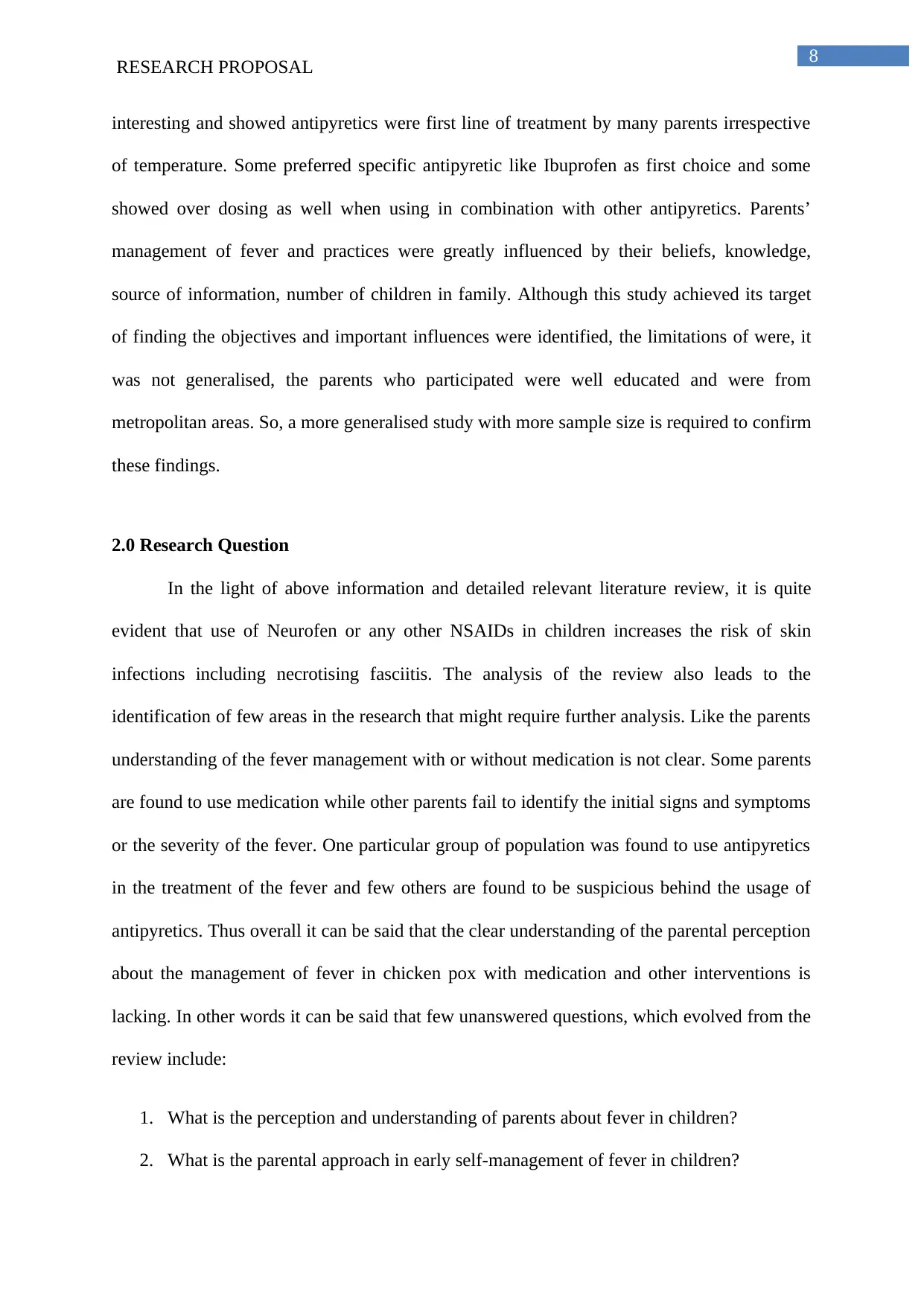
8
RESEARCH PROPOSAL
interesting and showed antipyretics were first line of treatment by many parents irrespective
of temperature. Some preferred specific antipyretic like Ibuprofen as first choice and some
showed over dosing as well when using in combination with other antipyretics. Parents’
management of fever and practices were greatly influenced by their beliefs, knowledge,
source of information, number of children in family. Although this study achieved its target
of finding the objectives and important influences were identified, the limitations of were, it
was not generalised, the parents who participated were well educated and were from
metropolitan areas. So, a more generalised study with more sample size is required to confirm
these findings.
2.0 Research Question
In the light of above information and detailed relevant literature review, it is quite
evident that use of Neurofen or any other NSAIDs in children increases the risk of skin
infections including necrotising fasciitis. The analysis of the review also leads to the
identification of few areas in the research that might require further analysis. Like the parents
understanding of the fever management with or without medication is not clear. Some parents
are found to use medication while other parents fail to identify the initial signs and symptoms
or the severity of the fever. One particular group of population was found to use antipyretics
in the treatment of the fever and few others are found to be suspicious behind the usage of
antipyretics. Thus overall it can be said that the clear understanding of the parental perception
about the management of fever in chicken pox with medication and other interventions is
lacking. In other words it can be said that few unanswered questions, which evolved from the
review include:
1. What is the perception and understanding of parents about fever in children?
2. What is the parental approach in early self-management of fever in children?
RESEARCH PROPOSAL
interesting and showed antipyretics were first line of treatment by many parents irrespective
of temperature. Some preferred specific antipyretic like Ibuprofen as first choice and some
showed over dosing as well when using in combination with other antipyretics. Parents’
management of fever and practices were greatly influenced by their beliefs, knowledge,
source of information, number of children in family. Although this study achieved its target
of finding the objectives and important influences were identified, the limitations of were, it
was not generalised, the parents who participated were well educated and were from
metropolitan areas. So, a more generalised study with more sample size is required to confirm
these findings.
2.0 Research Question
In the light of above information and detailed relevant literature review, it is quite
evident that use of Neurofen or any other NSAIDs in children increases the risk of skin
infections including necrotising fasciitis. The analysis of the review also leads to the
identification of few areas in the research that might require further analysis. Like the parents
understanding of the fever management with or without medication is not clear. Some parents
are found to use medication while other parents fail to identify the initial signs and symptoms
or the severity of the fever. One particular group of population was found to use antipyretics
in the treatment of the fever and few others are found to be suspicious behind the usage of
antipyretics. Thus overall it can be said that the clear understanding of the parental perception
about the management of fever in chicken pox with medication and other interventions is
lacking. In other words it can be said that few unanswered questions, which evolved from the
review include:
1. What is the perception and understanding of parents about fever in children?
2. What is the parental approach in early self-management of fever in children?
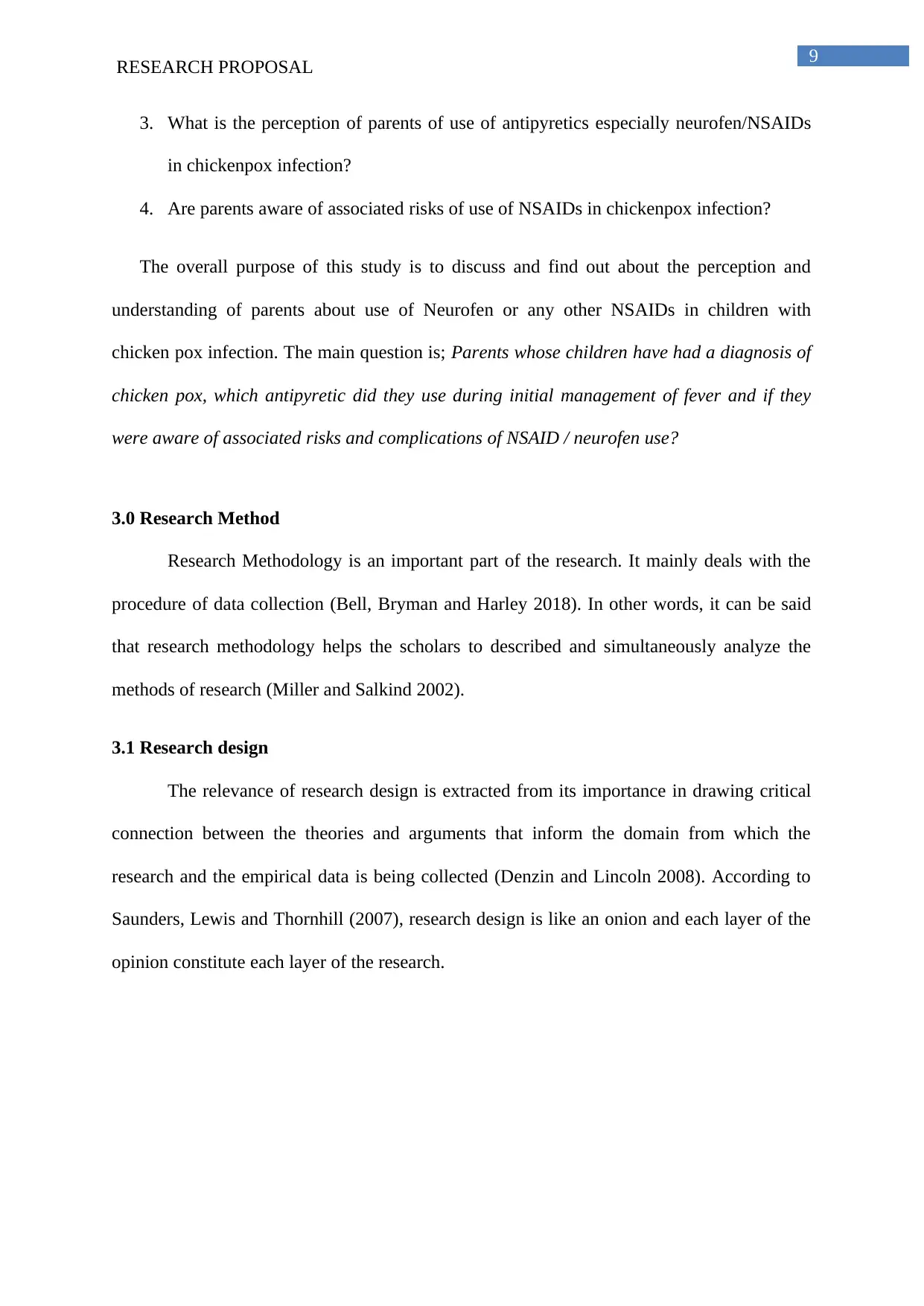
9
RESEARCH PROPOSAL
3. What is the perception of parents of use of antipyretics especially neurofen/NSAIDs
in chickenpox infection?
4. Are parents aware of associated risks of use of NSAIDs in chickenpox infection?
The overall purpose of this study is to discuss and find out about the perception and
understanding of parents about use of Neurofen or any other NSAIDs in children with
chicken pox infection. The main question is; Parents whose children have had a diagnosis of
chicken pox, which antipyretic did they use during initial management of fever and if they
were aware of associated risks and complications of NSAID / neurofen use?
3.0 Research Method
Research Methodology is an important part of the research. It mainly deals with the
procedure of data collection (Bell, Bryman and Harley 2018). In other words, it can be said
that research methodology helps the scholars to described and simultaneously analyze the
methods of research (Miller and Salkind 2002).
3.1 Research design
The relevance of research design is extracted from its importance in drawing critical
connection between the theories and arguments that inform the domain from which the
research and the empirical data is being collected (Denzin and Lincoln 2008). According to
Saunders, Lewis and Thornhill (2007), research design is like an onion and each layer of the
opinion constitute each layer of the research.
RESEARCH PROPOSAL
3. What is the perception of parents of use of antipyretics especially neurofen/NSAIDs
in chickenpox infection?
4. Are parents aware of associated risks of use of NSAIDs in chickenpox infection?
The overall purpose of this study is to discuss and find out about the perception and
understanding of parents about use of Neurofen or any other NSAIDs in children with
chicken pox infection. The main question is; Parents whose children have had a diagnosis of
chicken pox, which antipyretic did they use during initial management of fever and if they
were aware of associated risks and complications of NSAID / neurofen use?
3.0 Research Method
Research Methodology is an important part of the research. It mainly deals with the
procedure of data collection (Bell, Bryman and Harley 2018). In other words, it can be said
that research methodology helps the scholars to described and simultaneously analyze the
methods of research (Miller and Salkind 2002).
3.1 Research design
The relevance of research design is extracted from its importance in drawing critical
connection between the theories and arguments that inform the domain from which the
research and the empirical data is being collected (Denzin and Lincoln 2008). According to
Saunders, Lewis and Thornhill (2007), research design is like an onion and each layer of the
opinion constitute each layer of the research.
Secure Best Marks with AI Grader
Need help grading? Try our AI Grader for instant feedback on your assignments.
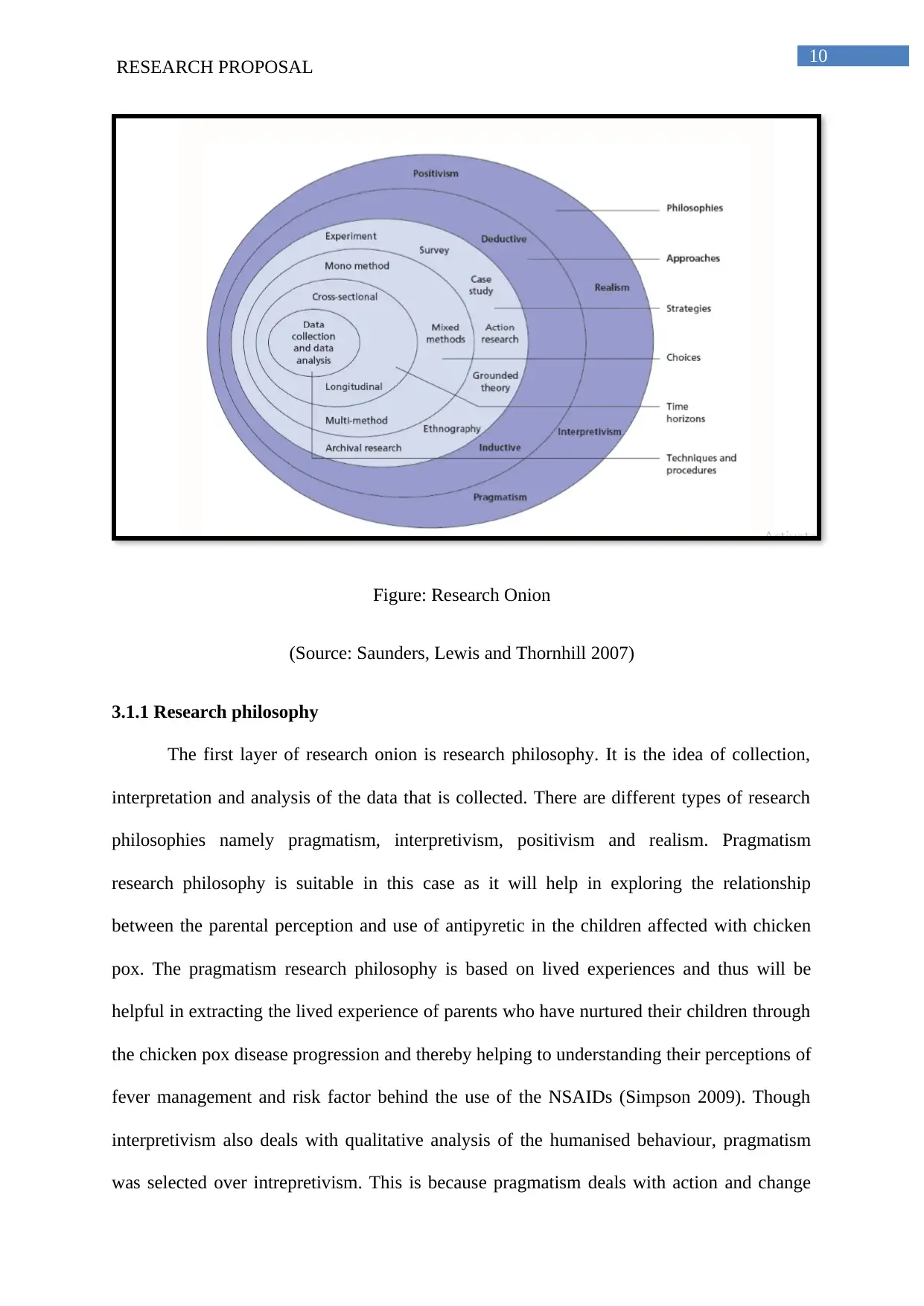
10
RESEARCH PROPOSAL
Figure: Research Onion
(Source: Saunders, Lewis and Thornhill 2007)
3.1.1 Research philosophy
The first layer of research onion is research philosophy. It is the idea of collection,
interpretation and analysis of the data that is collected. There are different types of research
philosophies namely pragmatism, interpretivism, positivism and realism. Pragmatism
research philosophy is suitable in this case as it will help in exploring the relationship
between the parental perception and use of antipyretic in the children affected with chicken
pox. The pragmatism research philosophy is based on lived experiences and thus will be
helpful in extracting the lived experience of parents who have nurtured their children through
the chicken pox disease progression and thereby helping to understanding their perceptions of
fever management and risk factor behind the use of the NSAIDs (Simpson 2009). Though
interpretivism also deals with qualitative analysis of the humanised behaviour, pragmatism
was selected over intrepretivism. This is because pragmatism deals with action and change
RESEARCH PROPOSAL
Figure: Research Onion
(Source: Saunders, Lewis and Thornhill 2007)
3.1.1 Research philosophy
The first layer of research onion is research philosophy. It is the idea of collection,
interpretation and analysis of the data that is collected. There are different types of research
philosophies namely pragmatism, interpretivism, positivism and realism. Pragmatism
research philosophy is suitable in this case as it will help in exploring the relationship
between the parental perception and use of antipyretic in the children affected with chicken
pox. The pragmatism research philosophy is based on lived experiences and thus will be
helpful in extracting the lived experience of parents who have nurtured their children through
the chicken pox disease progression and thereby helping to understanding their perceptions of
fever management and risk factor behind the use of the NSAIDs (Simpson 2009). Though
interpretivism also deals with qualitative analysis of the humanised behaviour, pragmatism
was selected over intrepretivism. This is because pragmatism deals with action and change
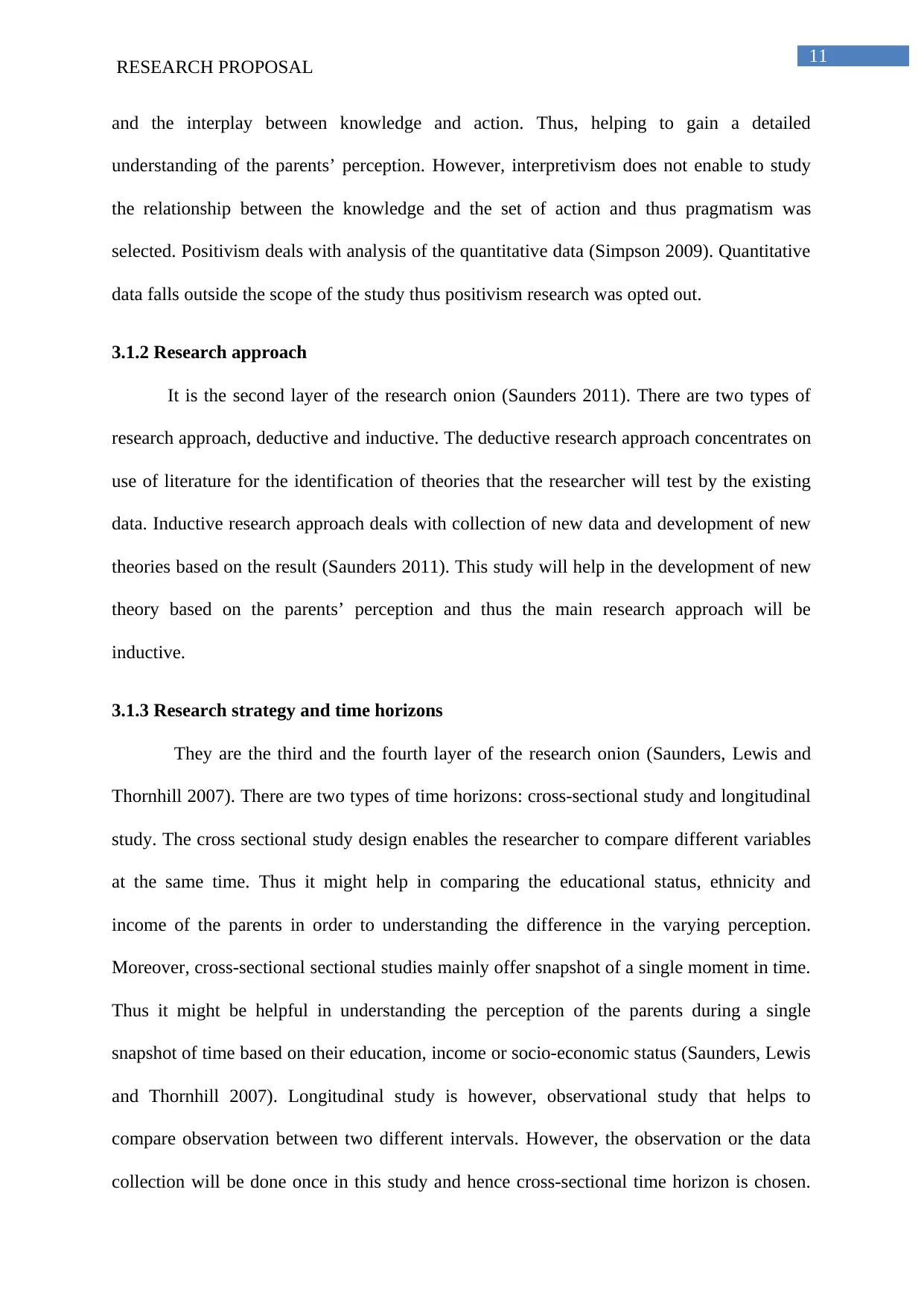
11
RESEARCH PROPOSAL
and the interplay between knowledge and action. Thus, helping to gain a detailed
understanding of the parents’ perception. However, interpretivism does not enable to study
the relationship between the knowledge and the set of action and thus pragmatism was
selected. Positivism deals with analysis of the quantitative data (Simpson 2009). Quantitative
data falls outside the scope of the study thus positivism research was opted out.
3.1.2 Research approach
It is the second layer of the research onion (Saunders 2011). There are two types of
research approach, deductive and inductive. The deductive research approach concentrates on
use of literature for the identification of theories that the researcher will test by the existing
data. Inductive research approach deals with collection of new data and development of new
theories based on the result (Saunders 2011). This study will help in the development of new
theory based on the parents’ perception and thus the main research approach will be
inductive.
3.1.3 Research strategy and time horizons
They are the third and the fourth layer of the research onion (Saunders, Lewis and
Thornhill 2007). There are two types of time horizons: cross-sectional study and longitudinal
study. The cross sectional study design enables the researcher to compare different variables
at the same time. Thus it might help in comparing the educational status, ethnicity and
income of the parents in order to understanding the difference in the varying perception.
Moreover, cross-sectional sectional studies mainly offer snapshot of a single moment in time.
Thus it might be helpful in understanding the perception of the parents during a single
snapshot of time based on their education, income or socio-economic status (Saunders, Lewis
and Thornhill 2007). Longitudinal study is however, observational study that helps to
compare observation between two different intervals. However, the observation or the data
collection will be done once in this study and hence cross-sectional time horizon is chosen.
RESEARCH PROPOSAL
and the interplay between knowledge and action. Thus, helping to gain a detailed
understanding of the parents’ perception. However, interpretivism does not enable to study
the relationship between the knowledge and the set of action and thus pragmatism was
selected. Positivism deals with analysis of the quantitative data (Simpson 2009). Quantitative
data falls outside the scope of the study thus positivism research was opted out.
3.1.2 Research approach
It is the second layer of the research onion (Saunders 2011). There are two types of
research approach, deductive and inductive. The deductive research approach concentrates on
use of literature for the identification of theories that the researcher will test by the existing
data. Inductive research approach deals with collection of new data and development of new
theories based on the result (Saunders 2011). This study will help in the development of new
theory based on the parents’ perception and thus the main research approach will be
inductive.
3.1.3 Research strategy and time horizons
They are the third and the fourth layer of the research onion (Saunders, Lewis and
Thornhill 2007). There are two types of time horizons: cross-sectional study and longitudinal
study. The cross sectional study design enables the researcher to compare different variables
at the same time. Thus it might help in comparing the educational status, ethnicity and
income of the parents in order to understanding the difference in the varying perception.
Moreover, cross-sectional sectional studies mainly offer snapshot of a single moment in time.
Thus it might be helpful in understanding the perception of the parents during a single
snapshot of time based on their education, income or socio-economic status (Saunders, Lewis
and Thornhill 2007). Longitudinal study is however, observational study that helps to
compare observation between two different intervals. However, the observation or the data
collection will be done once in this study and hence cross-sectional time horizon is chosen.
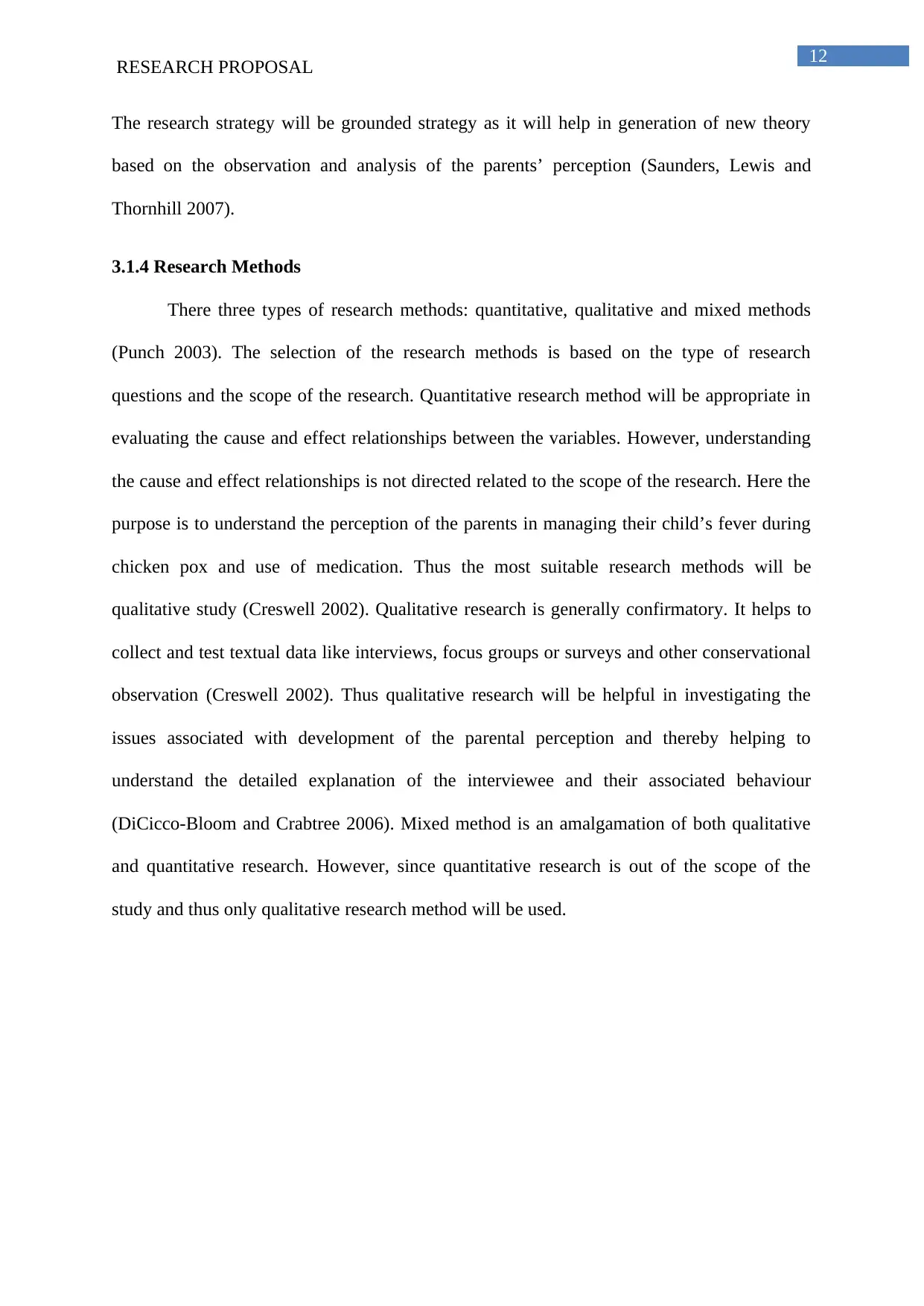
12
RESEARCH PROPOSAL
The research strategy will be grounded strategy as it will help in generation of new theory
based on the observation and analysis of the parents’ perception (Saunders, Lewis and
Thornhill 2007).
3.1.4 Research Methods
There three types of research methods: quantitative, qualitative and mixed methods
(Punch 2003). The selection of the research methods is based on the type of research
questions and the scope of the research. Quantitative research method will be appropriate in
evaluating the cause and effect relationships between the variables. However, understanding
the cause and effect relationships is not directed related to the scope of the research. Here the
purpose is to understand the perception of the parents in managing their child’s fever during
chicken pox and use of medication. Thus the most suitable research methods will be
qualitative study (Creswell 2002). Qualitative research is generally confirmatory. It helps to
collect and test textual data like interviews, focus groups or surveys and other conservational
observation (Creswell 2002). Thus qualitative research will be helpful in investigating the
issues associated with development of the parental perception and thereby helping to
understand the detailed explanation of the interviewee and their associated behaviour
(DiCicco‐Bloom and Crabtree 2006). Mixed method is an amalgamation of both qualitative
and quantitative research. However, since quantitative research is out of the scope of the
study and thus only qualitative research method will be used.
RESEARCH PROPOSAL
The research strategy will be grounded strategy as it will help in generation of new theory
based on the observation and analysis of the parents’ perception (Saunders, Lewis and
Thornhill 2007).
3.1.4 Research Methods
There three types of research methods: quantitative, qualitative and mixed methods
(Punch 2003). The selection of the research methods is based on the type of research
questions and the scope of the research. Quantitative research method will be appropriate in
evaluating the cause and effect relationships between the variables. However, understanding
the cause and effect relationships is not directed related to the scope of the research. Here the
purpose is to understand the perception of the parents in managing their child’s fever during
chicken pox and use of medication. Thus the most suitable research methods will be
qualitative study (Creswell 2002). Qualitative research is generally confirmatory. It helps to
collect and test textual data like interviews, focus groups or surveys and other conservational
observation (Creswell 2002). Thus qualitative research will be helpful in investigating the
issues associated with development of the parental perception and thereby helping to
understand the detailed explanation of the interviewee and their associated behaviour
(DiCicco‐Bloom and Crabtree 2006). Mixed method is an amalgamation of both qualitative
and quantitative research. However, since quantitative research is out of the scope of the
study and thus only qualitative research method will be used.
Paraphrase This Document
Need a fresh take? Get an instant paraphrase of this document with our AI Paraphraser
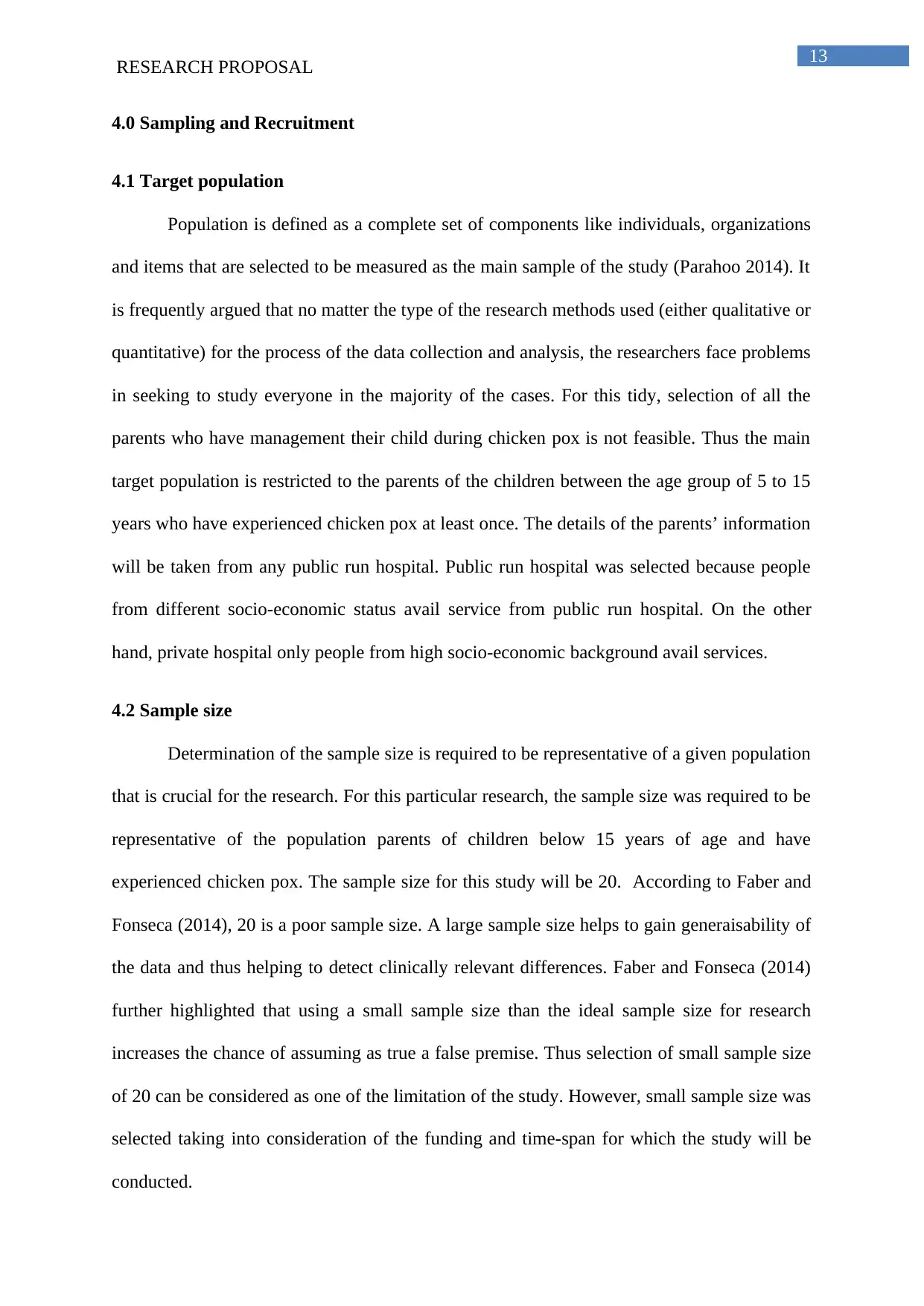
13
RESEARCH PROPOSAL
4.0 Sampling and Recruitment
4.1 Target population
Population is defined as a complete set of components like individuals, organizations
and items that are selected to be measured as the main sample of the study (Parahoo 2014). It
is frequently argued that no matter the type of the research methods used (either qualitative or
quantitative) for the process of the data collection and analysis, the researchers face problems
in seeking to study everyone in the majority of the cases. For this tidy, selection of all the
parents who have management their child during chicken pox is not feasible. Thus the main
target population is restricted to the parents of the children between the age group of 5 to 15
years who have experienced chicken pox at least once. The details of the parents’ information
will be taken from any public run hospital. Public run hospital was selected because people
from different socio-economic status avail service from public run hospital. On the other
hand, private hospital only people from high socio-economic background avail services.
4.2 Sample size
Determination of the sample size is required to be representative of a given population
that is crucial for the research. For this particular research, the sample size was required to be
representative of the population parents of children below 15 years of age and have
experienced chicken pox. The sample size for this study will be 20. According to Faber and
Fonseca (2014), 20 is a poor sample size. A large sample size helps to gain generaisability of
the data and thus helping to detect clinically relevant differences. Faber and Fonseca (2014)
further highlighted that using a small sample size than the ideal sample size for research
increases the chance of assuming as true a false premise. Thus selection of small sample size
of 20 can be considered as one of the limitation of the study. However, small sample size was
selected taking into consideration of the funding and time-span for which the study will be
conducted.
RESEARCH PROPOSAL
4.0 Sampling and Recruitment
4.1 Target population
Population is defined as a complete set of components like individuals, organizations
and items that are selected to be measured as the main sample of the study (Parahoo 2014). It
is frequently argued that no matter the type of the research methods used (either qualitative or
quantitative) for the process of the data collection and analysis, the researchers face problems
in seeking to study everyone in the majority of the cases. For this tidy, selection of all the
parents who have management their child during chicken pox is not feasible. Thus the main
target population is restricted to the parents of the children between the age group of 5 to 15
years who have experienced chicken pox at least once. The details of the parents’ information
will be taken from any public run hospital. Public run hospital was selected because people
from different socio-economic status avail service from public run hospital. On the other
hand, private hospital only people from high socio-economic background avail services.
4.2 Sample size
Determination of the sample size is required to be representative of a given population
that is crucial for the research. For this particular research, the sample size was required to be
representative of the population parents of children below 15 years of age and have
experienced chicken pox. The sample size for this study will be 20. According to Faber and
Fonseca (2014), 20 is a poor sample size. A large sample size helps to gain generaisability of
the data and thus helping to detect clinically relevant differences. Faber and Fonseca (2014)
further highlighted that using a small sample size than the ideal sample size for research
increases the chance of assuming as true a false premise. Thus selection of small sample size
of 20 can be considered as one of the limitation of the study. However, small sample size was
selected taking into consideration of the funding and time-span for which the study will be
conducted.
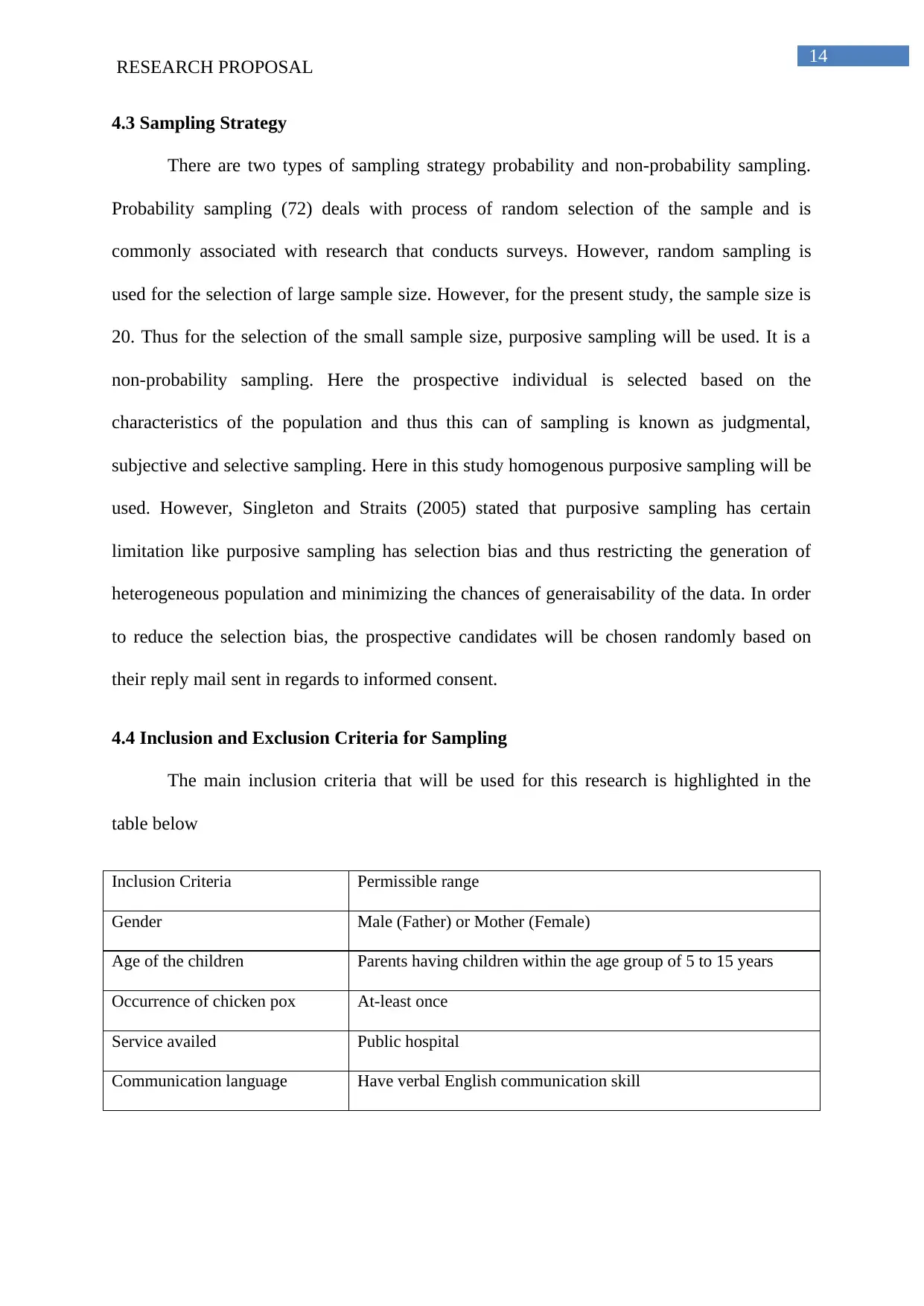
14
RESEARCH PROPOSAL
4.3 Sampling Strategy
There are two types of sampling strategy probability and non-probability sampling.
Probability sampling (72) deals with process of random selection of the sample and is
commonly associated with research that conducts surveys. However, random sampling is
used for the selection of large sample size. However, for the present study, the sample size is
20. Thus for the selection of the small sample size, purposive sampling will be used. It is a
non-probability sampling. Here the prospective individual is selected based on the
characteristics of the population and thus this can of sampling is known as judgmental,
subjective and selective sampling. Here in this study homogenous purposive sampling will be
used. However, Singleton and Straits (2005) stated that purposive sampling has certain
limitation like purposive sampling has selection bias and thus restricting the generation of
heterogeneous population and minimizing the chances of generaisability of the data. In order
to reduce the selection bias, the prospective candidates will be chosen randomly based on
their reply mail sent in regards to informed consent.
4.4 Inclusion and Exclusion Criteria for Sampling
The main inclusion criteria that will be used for this research is highlighted in the
table below
Inclusion Criteria Permissible range
Gender Male (Father) or Mother (Female)
Age of the children Parents having children within the age group of 5 to 15 years
Occurrence of chicken pox At-least once
Service availed Public hospital
Communication language Have verbal English communication skill
RESEARCH PROPOSAL
4.3 Sampling Strategy
There are two types of sampling strategy probability and non-probability sampling.
Probability sampling (72) deals with process of random selection of the sample and is
commonly associated with research that conducts surveys. However, random sampling is
used for the selection of large sample size. However, for the present study, the sample size is
20. Thus for the selection of the small sample size, purposive sampling will be used. It is a
non-probability sampling. Here the prospective individual is selected based on the
characteristics of the population and thus this can of sampling is known as judgmental,
subjective and selective sampling. Here in this study homogenous purposive sampling will be
used. However, Singleton and Straits (2005) stated that purposive sampling has certain
limitation like purposive sampling has selection bias and thus restricting the generation of
heterogeneous population and minimizing the chances of generaisability of the data. In order
to reduce the selection bias, the prospective candidates will be chosen randomly based on
their reply mail sent in regards to informed consent.
4.4 Inclusion and Exclusion Criteria for Sampling
The main inclusion criteria that will be used for this research is highlighted in the
table below
Inclusion Criteria Permissible range
Gender Male (Father) or Mother (Female)
Age of the children Parents having children within the age group of 5 to 15 years
Occurrence of chicken pox At-least once
Service availed Public hospital
Communication language Have verbal English communication skill
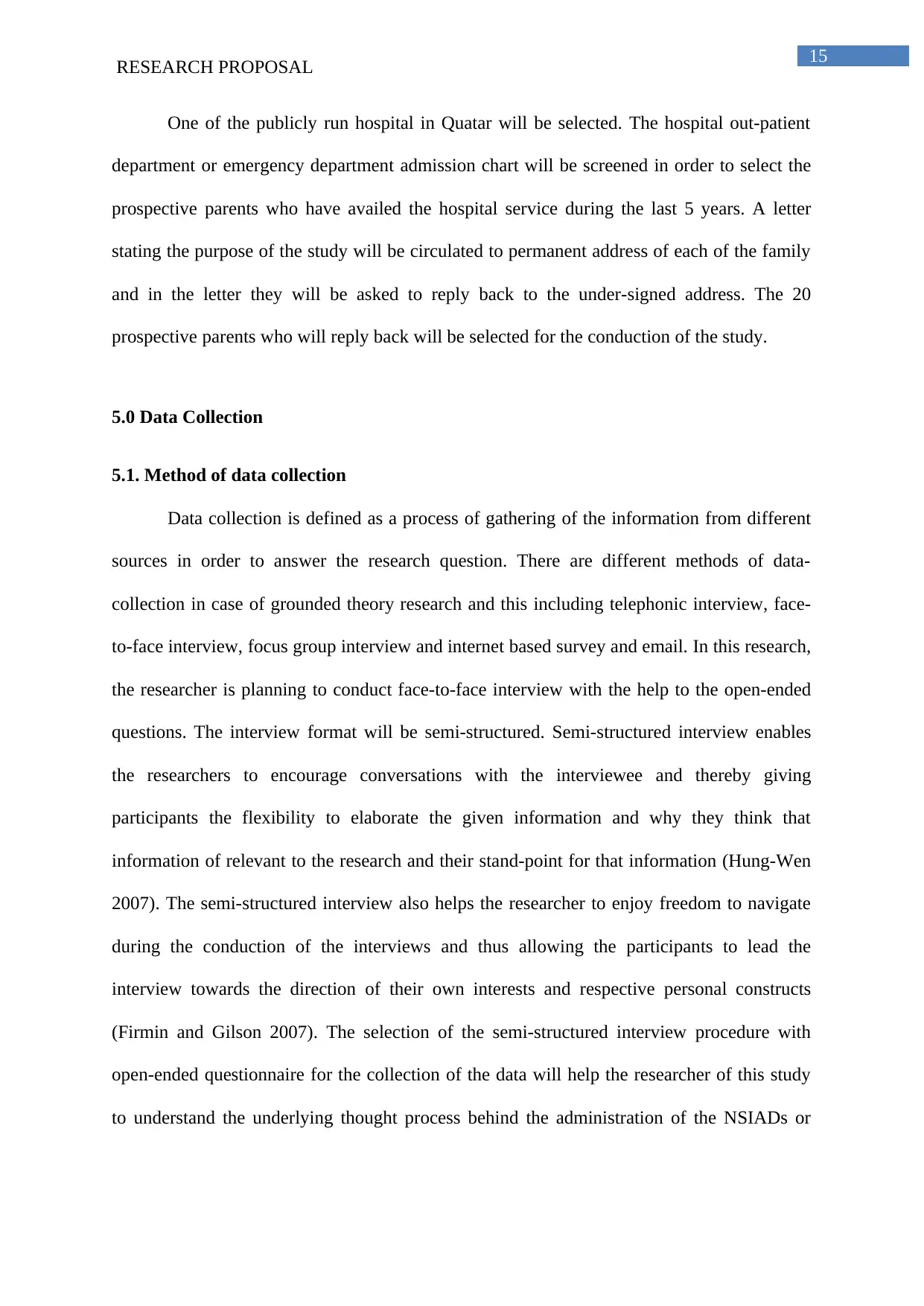
15
RESEARCH PROPOSAL
One of the publicly run hospital in Quatar will be selected. The hospital out-patient
department or emergency department admission chart will be screened in order to select the
prospective parents who have availed the hospital service during the last 5 years. A letter
stating the purpose of the study will be circulated to permanent address of each of the family
and in the letter they will be asked to reply back to the under-signed address. The 20
prospective parents who will reply back will be selected for the conduction of the study.
5.0 Data Collection
5.1. Method of data collection
Data collection is defined as a process of gathering of the information from different
sources in order to answer the research question. There are different methods of data-
collection in case of grounded theory research and this including telephonic interview, face-
to-face interview, focus group interview and internet based survey and email. In this research,
the researcher is planning to conduct face-to-face interview with the help to the open-ended
questions. The interview format will be semi-structured. Semi-structured interview enables
the researchers to encourage conversations with the interviewee and thereby giving
participants the flexibility to elaborate the given information and why they think that
information of relevant to the research and their stand-point for that information (Hung-Wen
2007). The semi-structured interview also helps the researcher to enjoy freedom to navigate
during the conduction of the interviews and thus allowing the participants to lead the
interview towards the direction of their own interests and respective personal constructs
(Firmin and Gilson 2007). The selection of the semi-structured interview procedure with
open-ended questionnaire for the collection of the data will help the researcher of this study
to understand the underlying thought process behind the administration of the NSIADs or
RESEARCH PROPOSAL
One of the publicly run hospital in Quatar will be selected. The hospital out-patient
department or emergency department admission chart will be screened in order to select the
prospective parents who have availed the hospital service during the last 5 years. A letter
stating the purpose of the study will be circulated to permanent address of each of the family
and in the letter they will be asked to reply back to the under-signed address. The 20
prospective parents who will reply back will be selected for the conduction of the study.
5.0 Data Collection
5.1. Method of data collection
Data collection is defined as a process of gathering of the information from different
sources in order to answer the research question. There are different methods of data-
collection in case of grounded theory research and this including telephonic interview, face-
to-face interview, focus group interview and internet based survey and email. In this research,
the researcher is planning to conduct face-to-face interview with the help to the open-ended
questions. The interview format will be semi-structured. Semi-structured interview enables
the researchers to encourage conversations with the interviewee and thereby giving
participants the flexibility to elaborate the given information and why they think that
information of relevant to the research and their stand-point for that information (Hung-Wen
2007). The semi-structured interview also helps the researcher to enjoy freedom to navigate
during the conduction of the interviews and thus allowing the participants to lead the
interview towards the direction of their own interests and respective personal constructs
(Firmin and Gilson 2007). The selection of the semi-structured interview procedure with
open-ended questionnaire for the collection of the data will help the researcher of this study
to understand the underlying thought process behind the administration of the NSIADs or
Secure Best Marks with AI Grader
Need help grading? Try our AI Grader for instant feedback on your assignments.
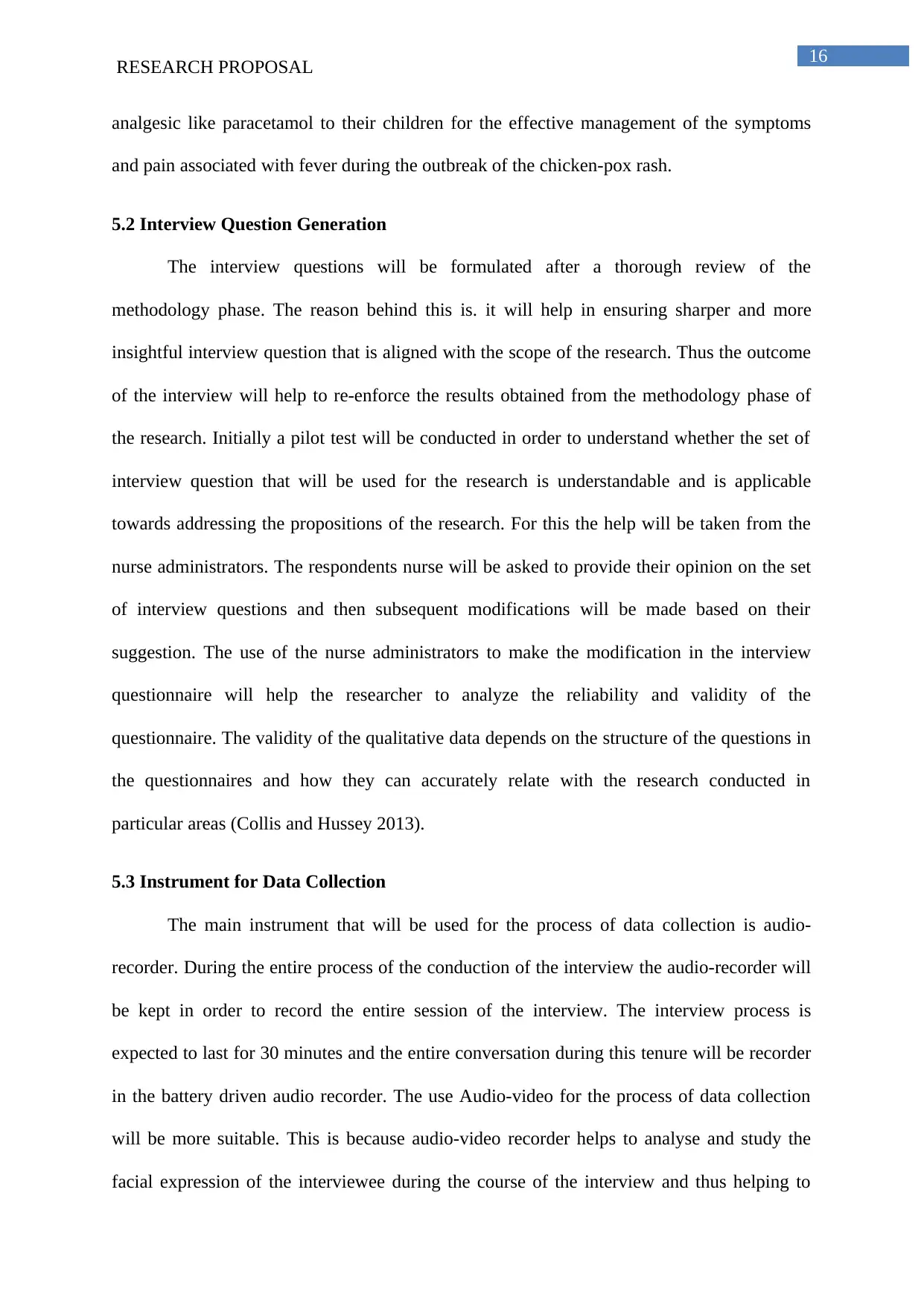
16
RESEARCH PROPOSAL
analgesic like paracetamol to their children for the effective management of the symptoms
and pain associated with fever during the outbreak of the chicken-pox rash.
5.2 Interview Question Generation
The interview questions will be formulated after a thorough review of the
methodology phase. The reason behind this is. it will help in ensuring sharper and more
insightful interview question that is aligned with the scope of the research. Thus the outcome
of the interview will help to re-enforce the results obtained from the methodology phase of
the research. Initially a pilot test will be conducted in order to understand whether the set of
interview question that will be used for the research is understandable and is applicable
towards addressing the propositions of the research. For this the help will be taken from the
nurse administrators. The respondents nurse will be asked to provide their opinion on the set
of interview questions and then subsequent modifications will be made based on their
suggestion. The use of the nurse administrators to make the modification in the interview
questionnaire will help the researcher to analyze the reliability and validity of the
questionnaire. The validity of the qualitative data depends on the structure of the questions in
the questionnaires and how they can accurately relate with the research conducted in
particular areas (Collis and Hussey 2013).
5.3 Instrument for Data Collection
The main instrument that will be used for the process of data collection is audio-
recorder. During the entire process of the conduction of the interview the audio-recorder will
be kept in order to record the entire session of the interview. The interview process is
expected to last for 30 minutes and the entire conversation during this tenure will be recorder
in the battery driven audio recorder. The use Audio-video for the process of data collection
will be more suitable. This is because audio-video recorder helps to analyse and study the
facial expression of the interviewee during the course of the interview and thus helping to
RESEARCH PROPOSAL
analgesic like paracetamol to their children for the effective management of the symptoms
and pain associated with fever during the outbreak of the chicken-pox rash.
5.2 Interview Question Generation
The interview questions will be formulated after a thorough review of the
methodology phase. The reason behind this is. it will help in ensuring sharper and more
insightful interview question that is aligned with the scope of the research. Thus the outcome
of the interview will help to re-enforce the results obtained from the methodology phase of
the research. Initially a pilot test will be conducted in order to understand whether the set of
interview question that will be used for the research is understandable and is applicable
towards addressing the propositions of the research. For this the help will be taken from the
nurse administrators. The respondents nurse will be asked to provide their opinion on the set
of interview questions and then subsequent modifications will be made based on their
suggestion. The use of the nurse administrators to make the modification in the interview
questionnaire will help the researcher to analyze the reliability and validity of the
questionnaire. The validity of the qualitative data depends on the structure of the questions in
the questionnaires and how they can accurately relate with the research conducted in
particular areas (Collis and Hussey 2013).
5.3 Instrument for Data Collection
The main instrument that will be used for the process of data collection is audio-
recorder. During the entire process of the conduction of the interview the audio-recorder will
be kept in order to record the entire session of the interview. The interview process is
expected to last for 30 minutes and the entire conversation during this tenure will be recorder
in the battery driven audio recorder. The use Audio-video for the process of data collection
will be more suitable. This is because audio-video recorder helps to analyse and study the
facial expression of the interviewee during the course of the interview and thus helping to
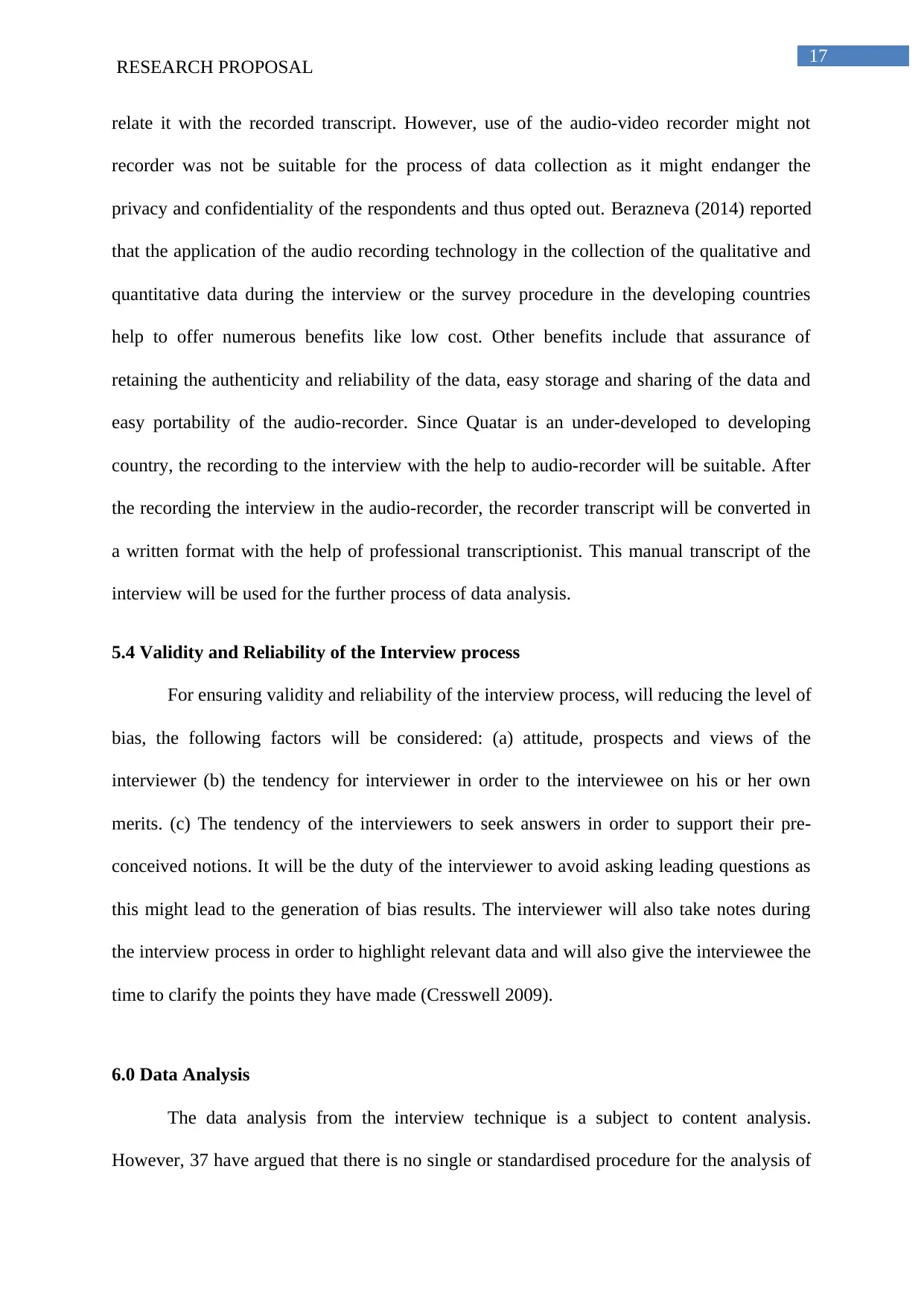
17
RESEARCH PROPOSAL
relate it with the recorded transcript. However, use of the audio-video recorder might not
recorder was not be suitable for the process of data collection as it might endanger the
privacy and confidentiality of the respondents and thus opted out. Berazneva (2014) reported
that the application of the audio recording technology in the collection of the qualitative and
quantitative data during the interview or the survey procedure in the developing countries
help to offer numerous benefits like low cost. Other benefits include that assurance of
retaining the authenticity and reliability of the data, easy storage and sharing of the data and
easy portability of the audio-recorder. Since Quatar is an under-developed to developing
country, the recording to the interview with the help to audio-recorder will be suitable. After
the recording the interview in the audio-recorder, the recorder transcript will be converted in
a written format with the help of professional transcriptionist. This manual transcript of the
interview will be used for the further process of data analysis.
5.4 Validity and Reliability of the Interview process
For ensuring validity and reliability of the interview process, will reducing the level of
bias, the following factors will be considered: (a) attitude, prospects and views of the
interviewer (b) the tendency for interviewer in order to the interviewee on his or her own
merits. (c) The tendency of the interviewers to seek answers in order to support their pre-
conceived notions. It will be the duty of the interviewer to avoid asking leading questions as
this might lead to the generation of bias results. The interviewer will also take notes during
the interview process in order to highlight relevant data and will also give the interviewee the
time to clarify the points they have made (Cresswell 2009).
6.0 Data Analysis
The data analysis from the interview technique is a subject to content analysis.
However, 37 have argued that there is no single or standardised procedure for the analysis of
RESEARCH PROPOSAL
relate it with the recorded transcript. However, use of the audio-video recorder might not
recorder was not be suitable for the process of data collection as it might endanger the
privacy and confidentiality of the respondents and thus opted out. Berazneva (2014) reported
that the application of the audio recording technology in the collection of the qualitative and
quantitative data during the interview or the survey procedure in the developing countries
help to offer numerous benefits like low cost. Other benefits include that assurance of
retaining the authenticity and reliability of the data, easy storage and sharing of the data and
easy portability of the audio-recorder. Since Quatar is an under-developed to developing
country, the recording to the interview with the help to audio-recorder will be suitable. After
the recording the interview in the audio-recorder, the recorder transcript will be converted in
a written format with the help of professional transcriptionist. This manual transcript of the
interview will be used for the further process of data analysis.
5.4 Validity and Reliability of the Interview process
For ensuring validity and reliability of the interview process, will reducing the level of
bias, the following factors will be considered: (a) attitude, prospects and views of the
interviewer (b) the tendency for interviewer in order to the interviewee on his or her own
merits. (c) The tendency of the interviewers to seek answers in order to support their pre-
conceived notions. It will be the duty of the interviewer to avoid asking leading questions as
this might lead to the generation of bias results. The interviewer will also take notes during
the interview process in order to highlight relevant data and will also give the interviewee the
time to clarify the points they have made (Cresswell 2009).
6.0 Data Analysis
The data analysis from the interview technique is a subject to content analysis.
However, 37 have argued that there is no single or standardised procedure for the analysis of
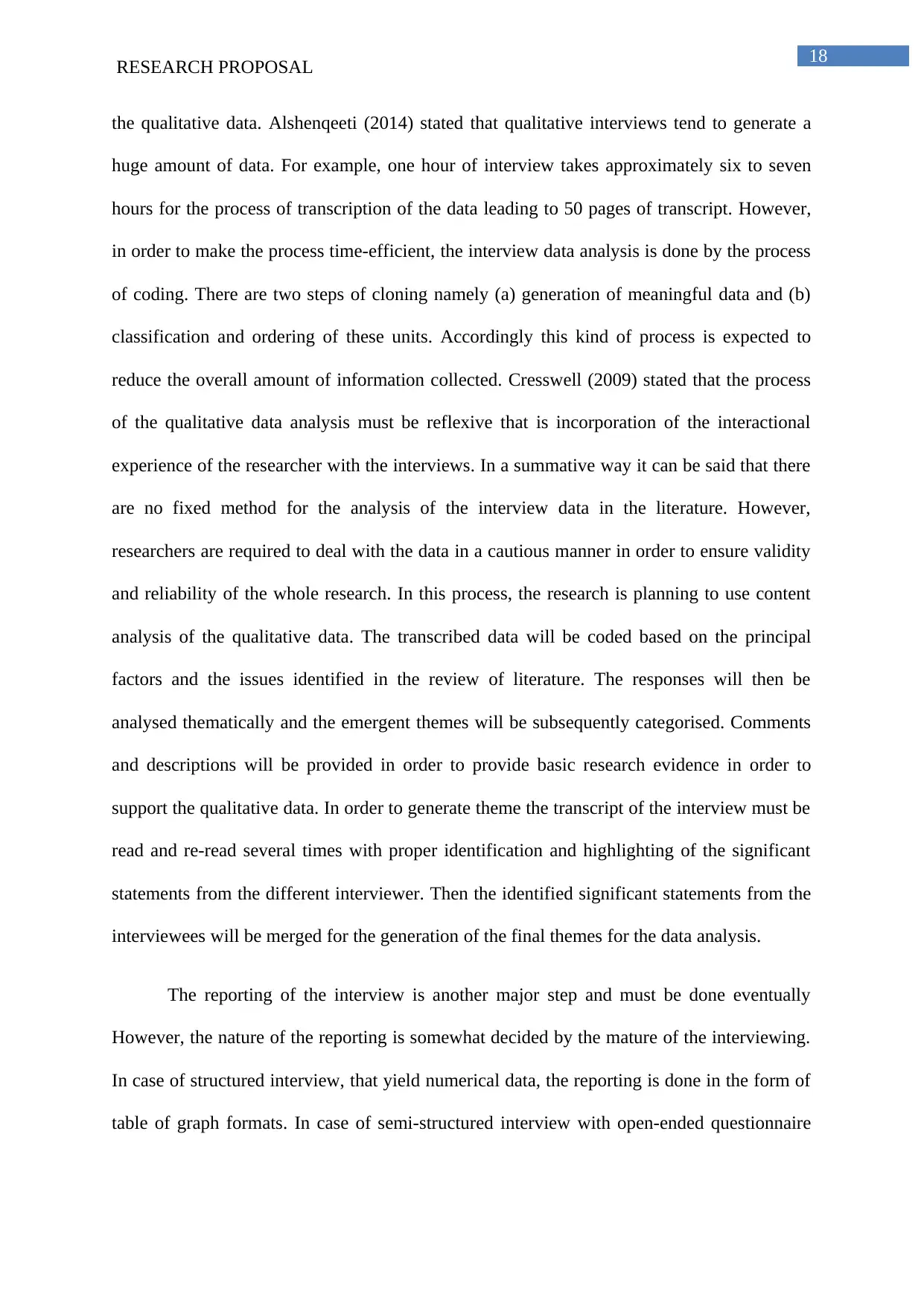
18
RESEARCH PROPOSAL
the qualitative data. Alshenqeeti (2014) stated that qualitative interviews tend to generate a
huge amount of data. For example, one hour of interview takes approximately six to seven
hours for the process of transcription of the data leading to 50 pages of transcript. However,
in order to make the process time-efficient, the interview data analysis is done by the process
of coding. There are two steps of cloning namely (a) generation of meaningful data and (b)
classification and ordering of these units. Accordingly this kind of process is expected to
reduce the overall amount of information collected. Cresswell (2009) stated that the process
of the qualitative data analysis must be reflexive that is incorporation of the interactional
experience of the researcher with the interviews. In a summative way it can be said that there
are no fixed method for the analysis of the interview data in the literature. However,
researchers are required to deal with the data in a cautious manner in order to ensure validity
and reliability of the whole research. In this process, the research is planning to use content
analysis of the qualitative data. The transcribed data will be coded based on the principal
factors and the issues identified in the review of literature. The responses will then be
analysed thematically and the emergent themes will be subsequently categorised. Comments
and descriptions will be provided in order to provide basic research evidence in order to
support the qualitative data. In order to generate theme the transcript of the interview must be
read and re-read several times with proper identification and highlighting of the significant
statements from the different interviewer. Then the identified significant statements from the
interviewees will be merged for the generation of the final themes for the data analysis.
The reporting of the interview is another major step and must be done eventually
However, the nature of the reporting is somewhat decided by the mature of the interviewing.
In case of structured interview, that yield numerical data, the reporting is done in the form of
table of graph formats. In case of semi-structured interview with open-ended questionnaire
RESEARCH PROPOSAL
the qualitative data. Alshenqeeti (2014) stated that qualitative interviews tend to generate a
huge amount of data. For example, one hour of interview takes approximately six to seven
hours for the process of transcription of the data leading to 50 pages of transcript. However,
in order to make the process time-efficient, the interview data analysis is done by the process
of coding. There are two steps of cloning namely (a) generation of meaningful data and (b)
classification and ordering of these units. Accordingly this kind of process is expected to
reduce the overall amount of information collected. Cresswell (2009) stated that the process
of the qualitative data analysis must be reflexive that is incorporation of the interactional
experience of the researcher with the interviews. In a summative way it can be said that there
are no fixed method for the analysis of the interview data in the literature. However,
researchers are required to deal with the data in a cautious manner in order to ensure validity
and reliability of the whole research. In this process, the research is planning to use content
analysis of the qualitative data. The transcribed data will be coded based on the principal
factors and the issues identified in the review of literature. The responses will then be
analysed thematically and the emergent themes will be subsequently categorised. Comments
and descriptions will be provided in order to provide basic research evidence in order to
support the qualitative data. In order to generate theme the transcript of the interview must be
read and re-read several times with proper identification and highlighting of the significant
statements from the different interviewer. Then the identified significant statements from the
interviewees will be merged for the generation of the final themes for the data analysis.
The reporting of the interview is another major step and must be done eventually
However, the nature of the reporting is somewhat decided by the mature of the interviewing.
In case of structured interview, that yield numerical data, the reporting is done in the form of
table of graph formats. In case of semi-structured interview with open-ended questionnaire
Paraphrase This Document
Need a fresh take? Get an instant paraphrase of this document with our AI Paraphraser
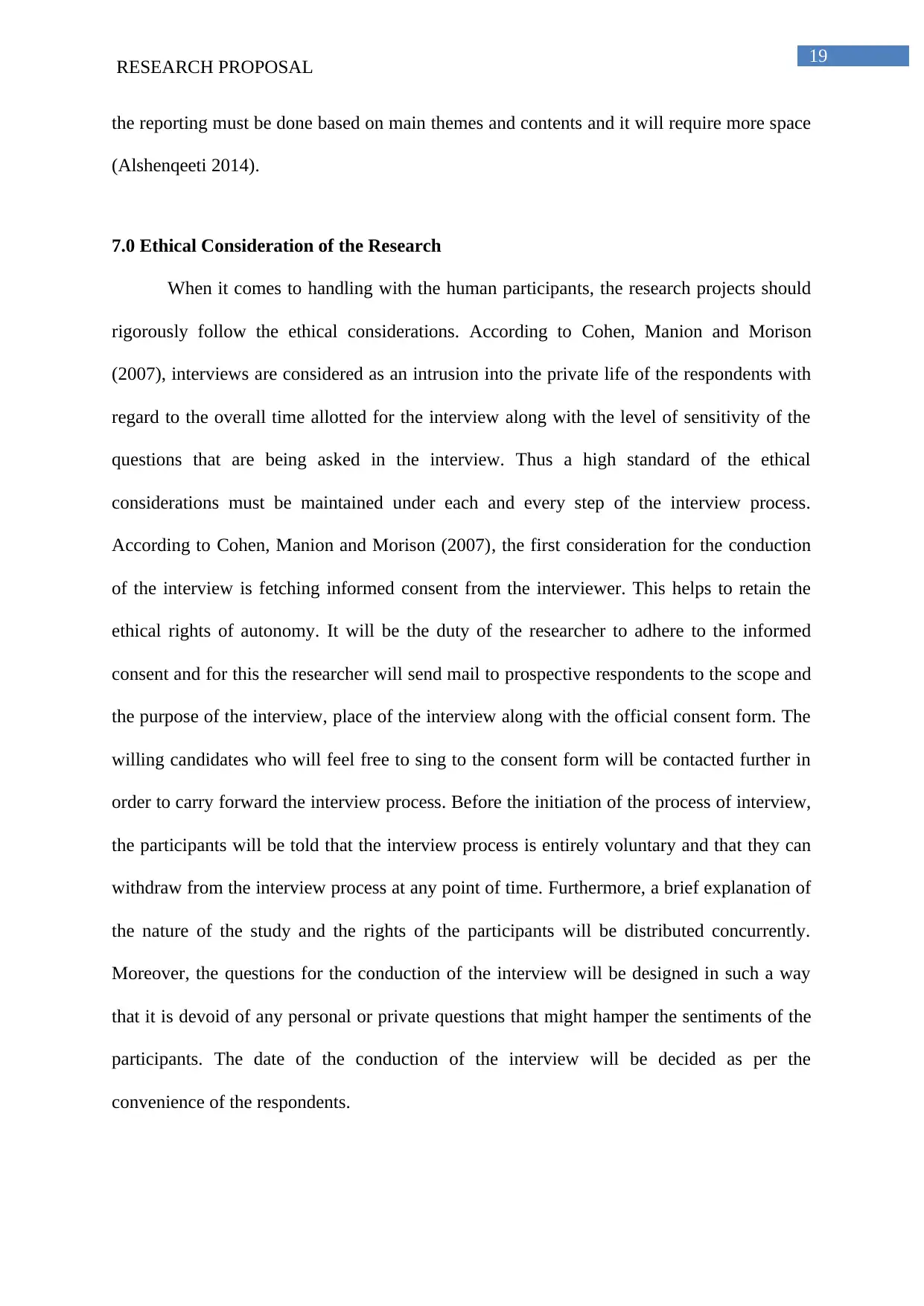
19
RESEARCH PROPOSAL
the reporting must be done based on main themes and contents and it will require more space
(Alshenqeeti 2014).
7.0 Ethical Consideration of the Research
When it comes to handling with the human participants, the research projects should
rigorously follow the ethical considerations. According to Cohen, Manion and Morison
(2007), interviews are considered as an intrusion into the private life of the respondents with
regard to the overall time allotted for the interview along with the level of sensitivity of the
questions that are being asked in the interview. Thus a high standard of the ethical
considerations must be maintained under each and every step of the interview process.
According to Cohen, Manion and Morison (2007), the first consideration for the conduction
of the interview is fetching informed consent from the interviewer. This helps to retain the
ethical rights of autonomy. It will be the duty of the researcher to adhere to the informed
consent and for this the researcher will send mail to prospective respondents to the scope and
the purpose of the interview, place of the interview along with the official consent form. The
willing candidates who will feel free to sing to the consent form will be contacted further in
order to carry forward the interview process. Before the initiation of the process of interview,
the participants will be told that the interview process is entirely voluntary and that they can
withdraw from the interview process at any point of time. Furthermore, a brief explanation of
the nature of the study and the rights of the participants will be distributed concurrently.
Moreover, the questions for the conduction of the interview will be designed in such a way
that it is devoid of any personal or private questions that might hamper the sentiments of the
participants. The date of the conduction of the interview will be decided as per the
convenience of the respondents.
RESEARCH PROPOSAL
the reporting must be done based on main themes and contents and it will require more space
(Alshenqeeti 2014).
7.0 Ethical Consideration of the Research
When it comes to handling with the human participants, the research projects should
rigorously follow the ethical considerations. According to Cohen, Manion and Morison
(2007), interviews are considered as an intrusion into the private life of the respondents with
regard to the overall time allotted for the interview along with the level of sensitivity of the
questions that are being asked in the interview. Thus a high standard of the ethical
considerations must be maintained under each and every step of the interview process.
According to Cohen, Manion and Morison (2007), the first consideration for the conduction
of the interview is fetching informed consent from the interviewer. This helps to retain the
ethical rights of autonomy. It will be the duty of the researcher to adhere to the informed
consent and for this the researcher will send mail to prospective respondents to the scope and
the purpose of the interview, place of the interview along with the official consent form. The
willing candidates who will feel free to sing to the consent form will be contacted further in
order to carry forward the interview process. Before the initiation of the process of interview,
the participants will be told that the interview process is entirely voluntary and that they can
withdraw from the interview process at any point of time. Furthermore, a brief explanation of
the nature of the study and the rights of the participants will be distributed concurrently.
Moreover, the questions for the conduction of the interview will be designed in such a way
that it is devoid of any personal or private questions that might hamper the sentiments of the
participants. The date of the conduction of the interview will be decided as per the
convenience of the respondents.
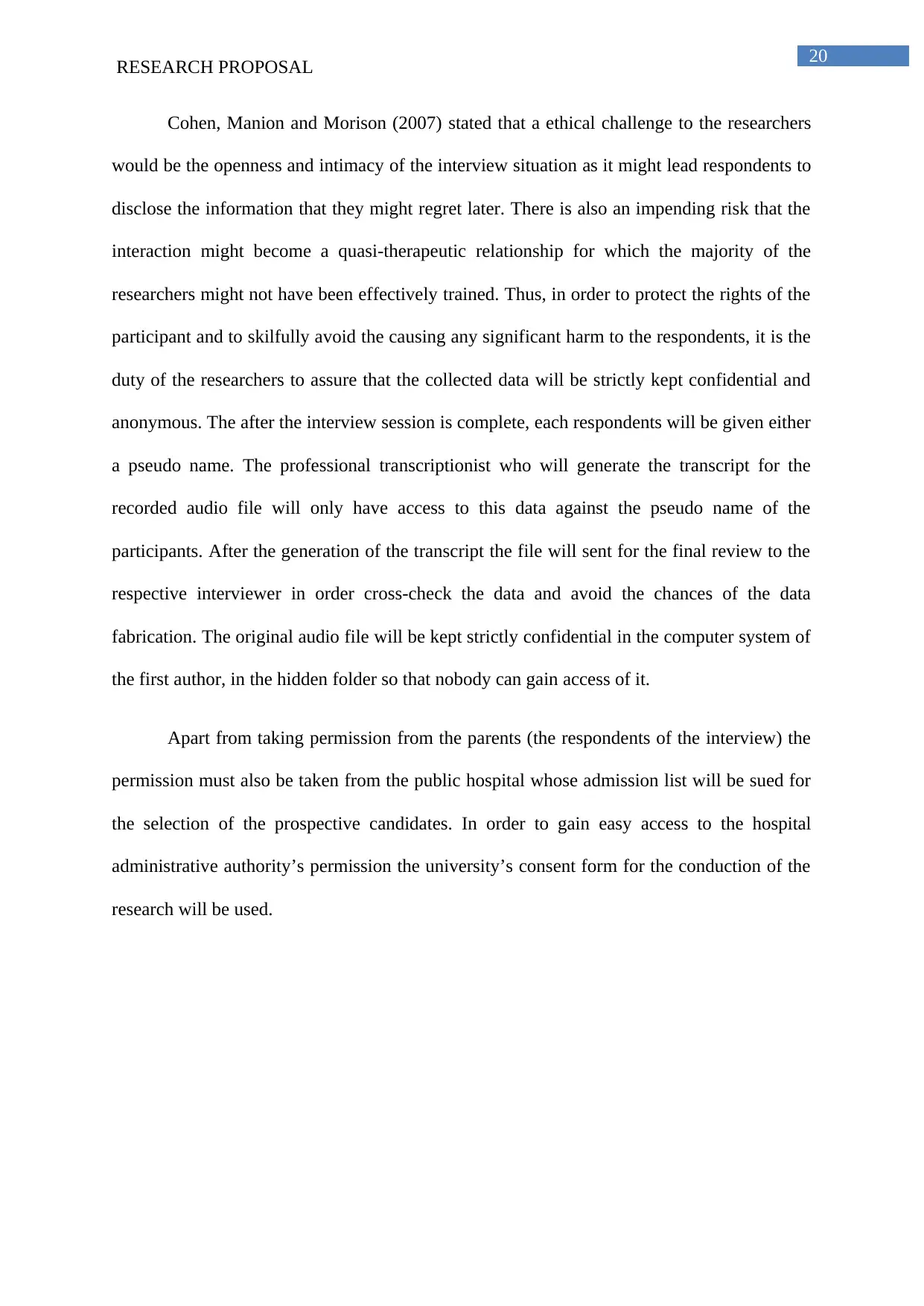
20
RESEARCH PROPOSAL
Cohen, Manion and Morison (2007) stated that a ethical challenge to the researchers
would be the openness and intimacy of the interview situation as it might lead respondents to
disclose the information that they might regret later. There is also an impending risk that the
interaction might become a quasi-therapeutic relationship for which the majority of the
researchers might not have been effectively trained. Thus, in order to protect the rights of the
participant and to skilfully avoid the causing any significant harm to the respondents, it is the
duty of the researchers to assure that the collected data will be strictly kept confidential and
anonymous. The after the interview session is complete, each respondents will be given either
a pseudo name. The professional transcriptionist who will generate the transcript for the
recorded audio file will only have access to this data against the pseudo name of the
participants. After the generation of the transcript the file will sent for the final review to the
respective interviewer in order cross-check the data and avoid the chances of the data
fabrication. The original audio file will be kept strictly confidential in the computer system of
the first author, in the hidden folder so that nobody can gain access of it.
Apart from taking permission from the parents (the respondents of the interview) the
permission must also be taken from the public hospital whose admission list will be sued for
the selection of the prospective candidates. In order to gain easy access to the hospital
administrative authority’s permission the university’s consent form for the conduction of the
research will be used.
RESEARCH PROPOSAL
Cohen, Manion and Morison (2007) stated that a ethical challenge to the researchers
would be the openness and intimacy of the interview situation as it might lead respondents to
disclose the information that they might regret later. There is also an impending risk that the
interaction might become a quasi-therapeutic relationship for which the majority of the
researchers might not have been effectively trained. Thus, in order to protect the rights of the
participant and to skilfully avoid the causing any significant harm to the respondents, it is the
duty of the researchers to assure that the collected data will be strictly kept confidential and
anonymous. The after the interview session is complete, each respondents will be given either
a pseudo name. The professional transcriptionist who will generate the transcript for the
recorded audio file will only have access to this data against the pseudo name of the
participants. After the generation of the transcript the file will sent for the final review to the
respective interviewer in order cross-check the data and avoid the chances of the data
fabrication. The original audio file will be kept strictly confidential in the computer system of
the first author, in the hidden folder so that nobody can gain access of it.
Apart from taking permission from the parents (the respondents of the interview) the
permission must also be taken from the public hospital whose admission list will be sued for
the selection of the prospective candidates. In order to gain easy access to the hospital
administrative authority’s permission the university’s consent form for the conduction of the
research will be used.
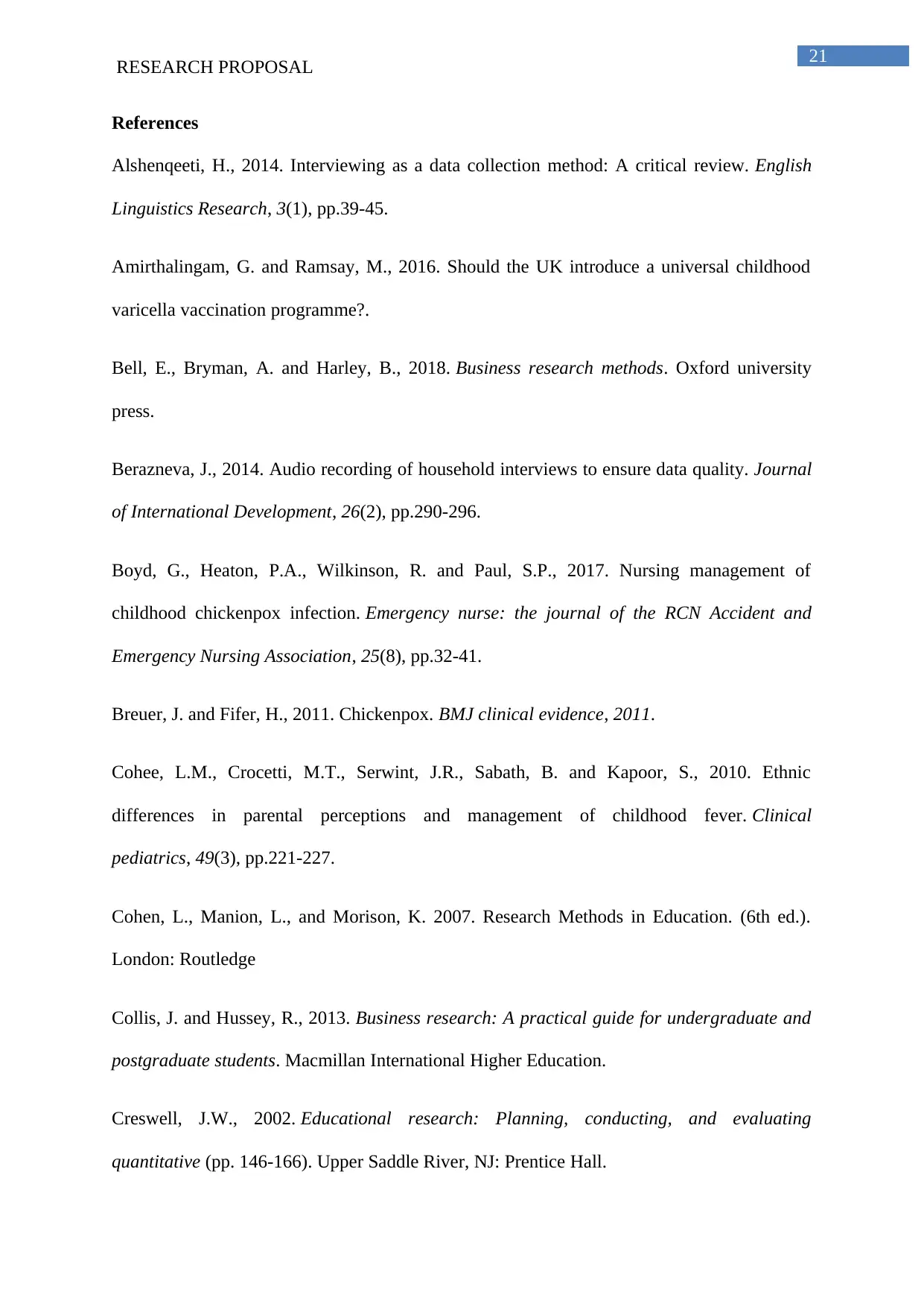
21
RESEARCH PROPOSAL
References
Alshenqeeti, H., 2014. Interviewing as a data collection method: A critical review. English
Linguistics Research, 3(1), pp.39-45.
Amirthalingam, G. and Ramsay, M., 2016. Should the UK introduce a universal childhood
varicella vaccination programme?.
Bell, E., Bryman, A. and Harley, B., 2018. Business research methods. Oxford university
press.
Berazneva, J., 2014. Audio recording of household interviews to ensure data quality. Journal
of International Development, 26(2), pp.290-296.
Boyd, G., Heaton, P.A., Wilkinson, R. and Paul, S.P., 2017. Nursing management of
childhood chickenpox infection. Emergency nurse: the journal of the RCN Accident and
Emergency Nursing Association, 25(8), pp.32-41.
Breuer, J. and Fifer, H., 2011. Chickenpox. BMJ clinical evidence, 2011.
Cohee, L.M., Crocetti, M.T., Serwint, J.R., Sabath, B. and Kapoor, S., 2010. Ethnic
differences in parental perceptions and management of childhood fever. Clinical
pediatrics, 49(3), pp.221-227.
Cohen, L., Manion, L., and Morison, K. 2007. Research Methods in Education. (6th ed.).
London: Routledge
Collis, J. and Hussey, R., 2013. Business research: A practical guide for undergraduate and
postgraduate students. Macmillan International Higher Education.
Creswell, J.W., 2002. Educational research: Planning, conducting, and evaluating
quantitative (pp. 146-166). Upper Saddle River, NJ: Prentice Hall.
RESEARCH PROPOSAL
References
Alshenqeeti, H., 2014. Interviewing as a data collection method: A critical review. English
Linguistics Research, 3(1), pp.39-45.
Amirthalingam, G. and Ramsay, M., 2016. Should the UK introduce a universal childhood
varicella vaccination programme?.
Bell, E., Bryman, A. and Harley, B., 2018. Business research methods. Oxford university
press.
Berazneva, J., 2014. Audio recording of household interviews to ensure data quality. Journal
of International Development, 26(2), pp.290-296.
Boyd, G., Heaton, P.A., Wilkinson, R. and Paul, S.P., 2017. Nursing management of
childhood chickenpox infection. Emergency nurse: the journal of the RCN Accident and
Emergency Nursing Association, 25(8), pp.32-41.
Breuer, J. and Fifer, H., 2011. Chickenpox. BMJ clinical evidence, 2011.
Cohee, L.M., Crocetti, M.T., Serwint, J.R., Sabath, B. and Kapoor, S., 2010. Ethnic
differences in parental perceptions and management of childhood fever. Clinical
pediatrics, 49(3), pp.221-227.
Cohen, L., Manion, L., and Morison, K. 2007. Research Methods in Education. (6th ed.).
London: Routledge
Collis, J. and Hussey, R., 2013. Business research: A practical guide for undergraduate and
postgraduate students. Macmillan International Higher Education.
Creswell, J.W., 2002. Educational research: Planning, conducting, and evaluating
quantitative (pp. 146-166). Upper Saddle River, NJ: Prentice Hall.
Secure Best Marks with AI Grader
Need help grading? Try our AI Grader for instant feedback on your assignments.
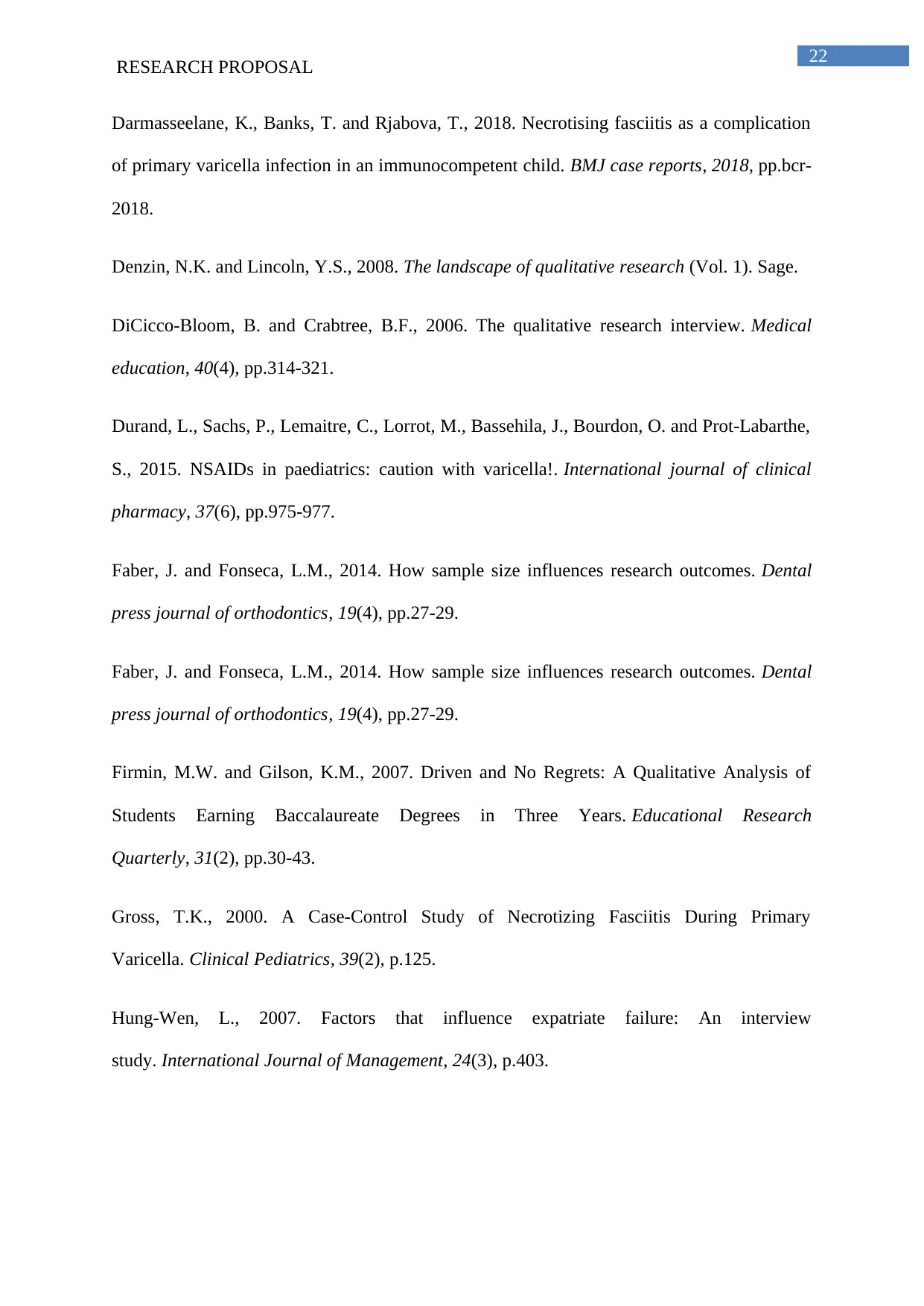
22
RESEARCH PROPOSAL
Darmasseelane, K., Banks, T. and Rjabova, T., 2018. Necrotising fasciitis as a complication
of primary varicella infection in an immunocompetent child. BMJ case reports, 2018, pp.bcr-
2018.
Denzin, N.K. and Lincoln, Y.S., 2008. The landscape of qualitative research (Vol. 1). Sage.
DiCicco‐Bloom, B. and Crabtree, B.F., 2006. The qualitative research interview. Medical
education, 40(4), pp.314-321.
Durand, L., Sachs, P., Lemaitre, C., Lorrot, M., Bassehila, J., Bourdon, O. and Prot-Labarthe,
S., 2015. NSAIDs in paediatrics: caution with varicella!. International journal of clinical
pharmacy, 37(6), pp.975-977.
Faber, J. and Fonseca, L.M., 2014. How sample size influences research outcomes. Dental
press journal of orthodontics, 19(4), pp.27-29.
Faber, J. and Fonseca, L.M., 2014. How sample size influences research outcomes. Dental
press journal of orthodontics, 19(4), pp.27-29.
Firmin, M.W. and Gilson, K.M., 2007. Driven and No Regrets: A Qualitative Analysis of
Students Earning Baccalaureate Degrees in Three Years. Educational Research
Quarterly, 31(2), pp.30-43.
Gross, T.K., 2000. A Case-Control Study of Necrotizing Fasciitis During Primary
Varicella. Clinical Pediatrics, 39(2), p.125.
Hung-Wen, L., 2007. Factors that influence expatriate failure: An interview
study. International Journal of Management, 24(3), p.403.
RESEARCH PROPOSAL
Darmasseelane, K., Banks, T. and Rjabova, T., 2018. Necrotising fasciitis as a complication
of primary varicella infection in an immunocompetent child. BMJ case reports, 2018, pp.bcr-
2018.
Denzin, N.K. and Lincoln, Y.S., 2008. The landscape of qualitative research (Vol. 1). Sage.
DiCicco‐Bloom, B. and Crabtree, B.F., 2006. The qualitative research interview. Medical
education, 40(4), pp.314-321.
Durand, L., Sachs, P., Lemaitre, C., Lorrot, M., Bassehila, J., Bourdon, O. and Prot-Labarthe,
S., 2015. NSAIDs in paediatrics: caution with varicella!. International journal of clinical
pharmacy, 37(6), pp.975-977.
Faber, J. and Fonseca, L.M., 2014. How sample size influences research outcomes. Dental
press journal of orthodontics, 19(4), pp.27-29.
Faber, J. and Fonseca, L.M., 2014. How sample size influences research outcomes. Dental
press journal of orthodontics, 19(4), pp.27-29.
Firmin, M.W. and Gilson, K.M., 2007. Driven and No Regrets: A Qualitative Analysis of
Students Earning Baccalaureate Degrees in Three Years. Educational Research
Quarterly, 31(2), pp.30-43.
Gross, T.K., 2000. A Case-Control Study of Necrotizing Fasciitis During Primary
Varicella. Clinical Pediatrics, 39(2), p.125.
Hung-Wen, L., 2007. Factors that influence expatriate failure: An interview
study. International Journal of Management, 24(3), p.403.
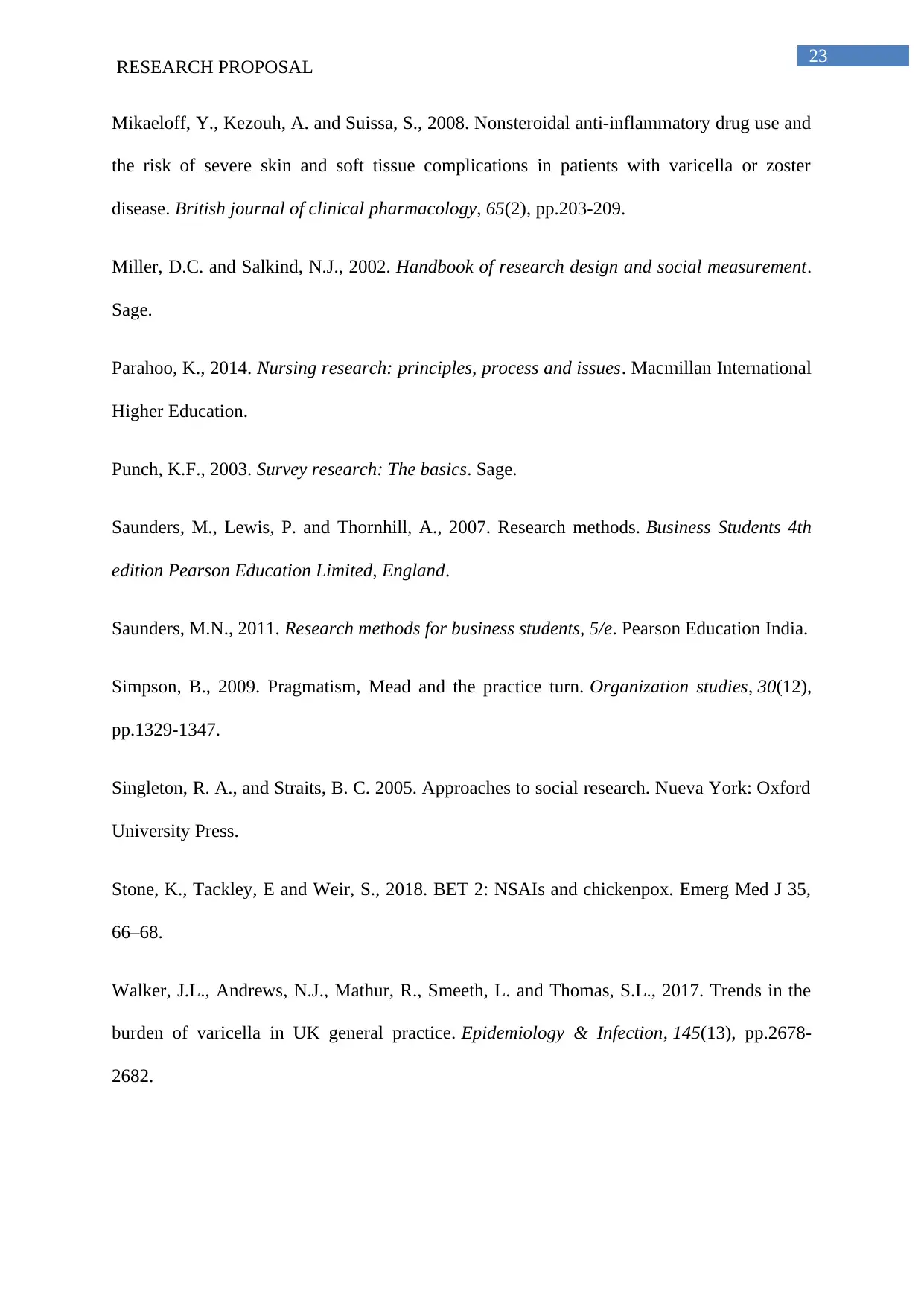
23
RESEARCH PROPOSAL
Mikaeloff, Y., Kezouh, A. and Suissa, S., 2008. Nonsteroidal anti‐inflammatory drug use and
the risk of severe skin and soft tissue complications in patients with varicella or zoster
disease. British journal of clinical pharmacology, 65(2), pp.203-209.
Miller, D.C. and Salkind, N.J., 2002. Handbook of research design and social measurement.
Sage.
Parahoo, K., 2014. Nursing research: principles, process and issues. Macmillan International
Higher Education.
Punch, K.F., 2003. Survey research: The basics. Sage.
Saunders, M., Lewis, P. and Thornhill, A., 2007. Research methods. Business Students 4th
edition Pearson Education Limited, England.
Saunders, M.N., 2011. Research methods for business students, 5/e. Pearson Education India.
Simpson, B., 2009. Pragmatism, Mead and the practice turn. Organization studies, 30(12),
pp.1329-1347.
Singleton, R. A., and Straits, B. C. 2005. Approaches to social research. Nueva York: Oxford
University Press.
Stone, K., Tackley, E and Weir, S., 2018. BET 2: NSAIs and chickenpox. Emerg Med J 35,
66–68.
Walker, J.L., Andrews, N.J., Mathur, R., Smeeth, L. and Thomas, S.L., 2017. Trends in the
burden of varicella in UK general practice. Epidemiology & Infection, 145(13), pp.2678-
2682.
RESEARCH PROPOSAL
Mikaeloff, Y., Kezouh, A. and Suissa, S., 2008. Nonsteroidal anti‐inflammatory drug use and
the risk of severe skin and soft tissue complications in patients with varicella or zoster
disease. British journal of clinical pharmacology, 65(2), pp.203-209.
Miller, D.C. and Salkind, N.J., 2002. Handbook of research design and social measurement.
Sage.
Parahoo, K., 2014. Nursing research: principles, process and issues. Macmillan International
Higher Education.
Punch, K.F., 2003. Survey research: The basics. Sage.
Saunders, M., Lewis, P. and Thornhill, A., 2007. Research methods. Business Students 4th
edition Pearson Education Limited, England.
Saunders, M.N., 2011. Research methods for business students, 5/e. Pearson Education India.
Simpson, B., 2009. Pragmatism, Mead and the practice turn. Organization studies, 30(12),
pp.1329-1347.
Singleton, R. A., and Straits, B. C. 2005. Approaches to social research. Nueva York: Oxford
University Press.
Stone, K., Tackley, E and Weir, S., 2018. BET 2: NSAIs and chickenpox. Emerg Med J 35,
66–68.
Walker, J.L., Andrews, N.J., Mathur, R., Smeeth, L. and Thomas, S.L., 2017. Trends in the
burden of varicella in UK general practice. Epidemiology & Infection, 145(13), pp.2678-
2682.

24
RESEARCH PROPOSAL
Walker, J.L., Andrews, N.J., Mathur, R., Smeeth, L. and Thomas, S.L., 2017. Trends in the
burden of varicella in UK general practice. Epidemiology & Infection, 145(13), pp.2678-
2682.
RESEARCH PROPOSAL
Walker, J.L., Andrews, N.J., Mathur, R., Smeeth, L. and Thomas, S.L., 2017. Trends in the
burden of varicella in UK general practice. Epidemiology & Infection, 145(13), pp.2678-
2682.
Paraphrase This Document
Need a fresh take? Get an instant paraphrase of this document with our AI Paraphraser
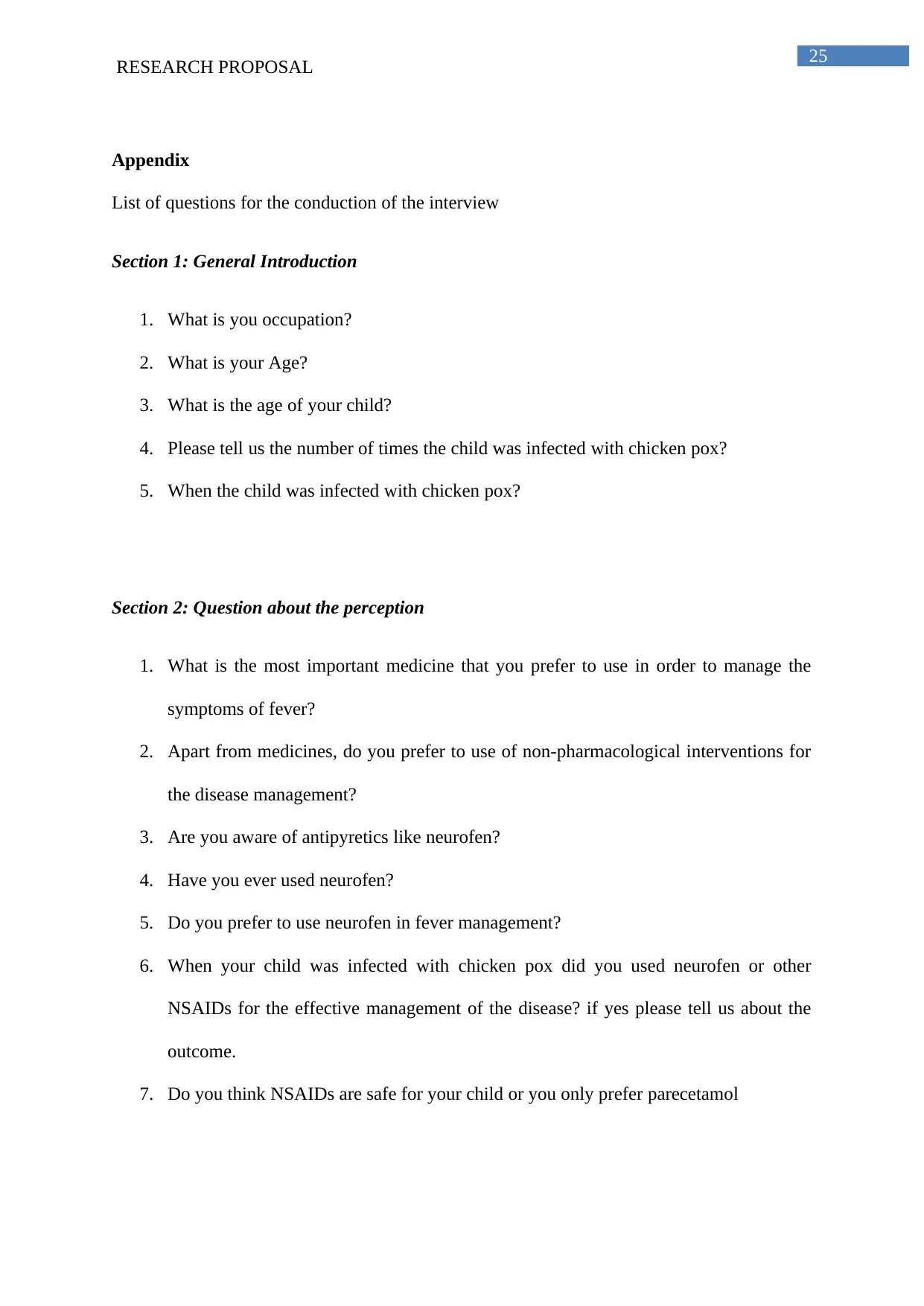
25
RESEARCH PROPOSAL
Appendix
List of questions for the conduction of the interview
Section 1: General Introduction
1. What is you occupation?
2. What is your Age?
3. What is the age of your child?
4. Please tell us the number of times the child was infected with chicken pox?
5. When the child was infected with chicken pox?
Section 2: Question about the perception
1. What is the most important medicine that you prefer to use in order to manage the
symptoms of fever?
2. Apart from medicines, do you prefer to use of non-pharmacological interventions for
the disease management?
3. Are you aware of antipyretics like neurofen?
4. Have you ever used neurofen?
5. Do you prefer to use neurofen in fever management?
6. When your child was infected with chicken pox did you used neurofen or other
NSAIDs for the effective management of the disease? if yes please tell us about the
outcome.
7. Do you think NSAIDs are safe for your child or you only prefer parecetamol
RESEARCH PROPOSAL
Appendix
List of questions for the conduction of the interview
Section 1: General Introduction
1. What is you occupation?
2. What is your Age?
3. What is the age of your child?
4. Please tell us the number of times the child was infected with chicken pox?
5. When the child was infected with chicken pox?
Section 2: Question about the perception
1. What is the most important medicine that you prefer to use in order to manage the
symptoms of fever?
2. Apart from medicines, do you prefer to use of non-pharmacological interventions for
the disease management?
3. Are you aware of antipyretics like neurofen?
4. Have you ever used neurofen?
5. Do you prefer to use neurofen in fever management?
6. When your child was infected with chicken pox did you used neurofen or other
NSAIDs for the effective management of the disease? if yes please tell us about the
outcome.
7. Do you think NSAIDs are safe for your child or you only prefer parecetamol

26
RESEARCH PROPOSAL
RESEARCH PROPOSAL
1 out of 27
Related Documents
Your All-in-One AI-Powered Toolkit for Academic Success.
+13062052269
info@desklib.com
Available 24*7 on WhatsApp / Email
![[object Object]](/_next/static/media/star-bottom.7253800d.svg)
Unlock your academic potential
© 2024 | Zucol Services PVT LTD | All rights reserved.





